











Whether
Contact us today to learn more about which



















Whether
Contact us today to learn more about which






We know a mother’s love helps us grow, and since her special day is also the perfect time to plant, a gift that grows might just make her day.
We have beautiful hanging baskets in full bloom, vegetable plants grown on our farm and colorful annuals, and our nurseries are stocked with trees, shrubs and perennials to keep the love growing long after Mother’s Day. Browse our garden centers for great gift ideas, too.
Still not sure what to get? A beautiful flower arrangement or bouquet and Adams gift card should fit just right!

adamsfarms.com






may 5 24

The former Beacon Correctional Facility, a female minimum security state prison on the outskirts of the city, closed in 2013. The 39-acre site awaits redevelopment.
Photo by David McIntyre
COMMUNITY PAGES, PAGE 42
6 On the Cover: Alon Koppel
The photographic sublimities of Alon Koppel.
10 Esteemed Reader
Jason Stern eulogizes a former teacher
13 Editor’s Note
Brian K. Mahoney tours the land of fire and ice.
14 The Fruits of Their Labor: Co-Ferments
Put simply, co-fermentation is the process of fermenting multiple things at once, together. Co-fermentation as a practice is nothing new, but local craft beverage producers are taking co-fermenting to the next level.
18 Craft Beverage Map
There are nearly 200 craft beverage producers in the region. Visit them all! Map by Mosa Tanksley.
27 Party Like It’s 1892
Helen and Tim Atkinson’s 4,300-square-foot Greek Revival in Uptown Kingston has a long history, from being burned to the ground by the British in 1777 to its rebirth in 1840 to being haunted by an Edwardian matron.
38 Healing Cycle
Following the death of their son Eric of an accidental overdose in 2016, Ginny and Mac Dorris launched The Ride for Mental Health, an annual fundraising ride in New Paltz that benefits the research and treatment work of McLean Hospital in Belmont, Massachusetts. To date, the Ride has raised over $1.7 million.
42 Beacon: Lighting the Way
A heated Beacon City Council meeting sees passionate debate over a Gaza ceasefire resolution, revealing deep local wounds and racial tensions. Amidst chaos, the resolution passes, but not without dissent. Meanwhile, Beacon grapples with economic shifts and affordability challenges, while entrepreneurs navigate a changing landscape. Future plans for the city promise both development and community engagement initiatives.
50 Beacon Portraits by David McIntyre
56 Dorothy’s: Pittsfield’s Living Room Expands
Dottie’s Coffee Lounge has taken over the space next door to offer dinner, late-night eats, and events in Pittsfield.
59 What’s Happening in April
Upcoming events in the Berkshires and NW Connecticut.


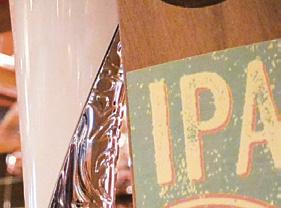
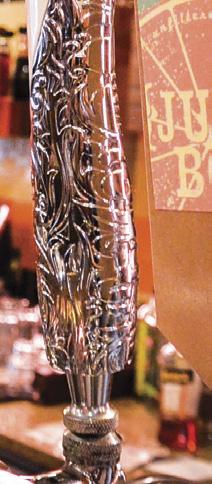












5 24
The library of the historic home of Helen and Tim Atkinson in Uptown Kingston.
Photo by Winona Barton-Ballentine HOME, PAGE 27
60 Music
Michael Eck reviews Laura by the John Esposito Sextet and Blues for Outlaw Hearts by the John Esposito Trio. Morgan Y. Evans reviews Of Earth and its Timely Delights by Camp Saint Helene. Jeremy Schwartz reviews The Deep End by Fortuneteller. Plus listening recommendations from DJs Amanda Joy and Paula Grace.
61 Books
Susan Yung reviews Help Wanted, the second novel from Rhinebeck-based author Adelle Waldman. Plus short reviews of The Eighth Moon by Jennifer Kabat; Diamond City by Marianna Boncek; Loving Scott: A Memoir by Pat Horner; Chopping Wood by Pete Seeger and David Bernz; and Circulating Jim Crow by Adam McKible.
62 Poetry
Poems by James Cronin, Fiona Emmi, Anne Kirby McCarthy, Olivia Song Miller, Jersey Montigo, Emily Murnane, Ricardo Enrique Murillo, Robert Phelps, Claire Scott, George J. Searles, J. R. Solonche, Matthew J. Spireng, Amanda Tiffany, and Stephen Jarrell Williams. Edited by Phillip X Levine.
64 Safe Space: Art Omi Pavilions
Construction kicks off this month at Art Omi Pavilions, an art park in Ghent to house selected artists’ work in perpetuity.
66 The Goddess Party features a choir of over 30 singers backed by a rock band performing hits by Kate Bush and the B-52s. At the Old Dutch Church in Kingston on May 4.
67 The “Restored and Rediscovered” festival at Jacob Burns Film Center in Pleasantville screens May 13-23.
79 “Spillover” at Bard’s Hessel Museum of Art is the the show to see this season according to Taliesin Thomas.
70 Here are the shows we’ll be attending this month: Colin Stetson at Opus 40, Pokey Lafarge at Levon Helm Studios, and Marc Ribot’s Ceramic Dog at Tubby’s.
72 Listings of museum and gallery shows across the region, including these highlights: “A Field Guide to Birds” at Garrison Art Center and “John Fleming Gould (19061996)” at Bannerman Island Gallery
76 Both and More! Jupiter Enters Gemini
Cory Nakasue reveals what the stars have in store for us.
80 Cultural Calendar What’s on our to-do list for May.

Alon Koppel and the Photographic Sublime
Catskill-based photographer Alon Koppel has been taking pictures all his life. When he’s not busy working as an architectural and art documentation photographer, you will most likely find him at specific spots along the Hudson, taking pictures when the light is right.
Employing a maritime app, he tracks ships coming and going on the Hudson River and makes a conscious effort to ensure that what the camera sees is exactly the same on different days, seasons, and weather conditions. His photographs show the movement of man through natural landscapes and are imbued with a meditative quality that reveals nature’s perpetual changes.
Always using a Canon R5 digital camera on a tripod and a set of ND (natural density) filters, which he compares to putting sunglasses on his camera, Koppel achieves long exposure times that create abstract stripes. With a nod to the Hudson River School Painters, the blurred results look almost like the brush strokes of paintings. “Photography is about capturing a scene in the right light. The mundane can look amazing in the morning glow, so I cross the river according to the time of day and light conditions. This is done in appreciation and
awareness of the works by the Hudson River School, whose founder Thomas Cole’s home is just up the hill from where I live. In my work, waiting for the ship to pass at the right moment, when the light is just perfect, is an extension of Thomas Cole and Frederic Church’s attempts at capturing the sublime American landscape,” he says.
“When I photograph from the Catskill side, the ship’s image appears just in front of Olana, Frederic Church’s home up on the hill. Photographing from this spot in the afternoon reveals Olana in its full evening glory, the sun bouncing off both the industrial ship traffic and the stately building behind it. The modern-day ship literally and figuratively disrupts the natural world,” he adds.
Through trial and error, Koppel has learnt to predict how long an exposure will be needed and how it will work at different times of day, resulting in how a train or a ship will look when it passes. Koppel’s photographs often appear in a series instead of just a single image. His work reflects both the exposure time of a specific image and shows how time changes the landscape and the environment over a longer duration.
For example, in one of his favorite locations, near
the city of Hudson, trees were lost to storms and decay. His photographs from 2021 and from 2024, from the same vantage point, reflect these subtle, environmental changes.
Diptychs from his “Locomotion” and “Shipping Lane” series are part of the group show “This Must Be the Place?” at Mad Rose Gallery in Millerton, which will be exhibited May 9 through June 9. Koppel’s photographs will be on display together with Lee Day and Jada Fabrizio (whose work appeared on the cover of the January issue of Chronogram), with an opening party Saturday, May 11 from 4 to 7pm.
Koppel’s photos will be further complemented by the inclusion of maritime maps displaying each photographed ship’s journey around the world over the course of a year.
He sums up his work saying, “I believe the beauty of the Hudson Valley is evident, yet human intervention is omnipresent. I hope the work can invite the viewer to recognize the effect of the constant commercial traffic around the world and the effects of consumerism and consumption on the natural world.”




EDITORIAL DIRECTOR Brian K. Mahoney brian.mahoney@chronogram.com
CREATIVE DIRECTOR David C. Perry david.perry@chronogram.com
DIGITAL EDITOR Marie Doyon marie.doyon@chronogram.com
ARTS EDITOR Peter Aaron music@chronogram.com
HOME EDITOR Mary Angeles Armstrong home@chronogram.com
POETRY EDITOR Phillip X Levine poetry@chronogram.com
CONTRIBUTING EDITOR Anne Pyburn Craig apcraig@chronogram.com
contributors
Winona Barton-Ballentine, Mike Cobb, Michael Eck, Melissa Esposito, Morgan Y. Evans, Lisa Green, Ryan Keegan, Elias Levey-Swain, David McIntyre, Cory Nakasue, Francesca Olsen, Seth Rogovoy, Jeremy Schwartz, Sparrow, Jaime Stathis, Mosa Tanksley, Taliesin Thomas, Marc J. Wrzesinski, Susan Yung
FOUNDERS Jason Stern, Amara Projansky
PUBLISHER & CEO Amara Projansky amara.projansky@chronogram.com
EXECUTIVE VICE PRESIDENT Jan Dewey jan.dewey@chronogram.com
BOARD CHAIR David Dell
sales manager
Andrea Fliakos andrea.fliakos@chronogram.com
media specialists
Kaitlyn LeLay kaitlyn.lelay@chronogram.com
Kelin Long-Gaye kelin.long-gaye@chronogram.com
Kris Schneider kris.schneider@chronogram.com
ad operations
Jared Winslow jared.winslow@chronogram.com
marketing
MARKETING & EVENTS MANAGER
Margot Isaacs margot.isaacs@chronogram.com
SPONSORED CONTENT EDITOR
Ashleigh Lovelace ashleigh.lovelace@chronogram.com
administration
FINANCE MANAGER

Nicole Clanahan accounting@chronogram.com; (845) 334-8600
production
PRODUCTION DIRECTOR
Kerry Tinger kerry.tinger@chronogram.com
PRODUCTION DESIGNER
Kate Brodowska kate.brodowska@chronogram.com
office
45 Pine Grove Avenue, Suite 303, Kingston, NY 12401 • (845) 334-8600
mission
Founded in 1993, Chronogram magazine offers a colorful and nuanced chronicle of life in the Hudson Valley, inviting readers into the arts, culture, and spirit of this place. All contents © 2024 Chronogram Media. ChronogramMedia.com
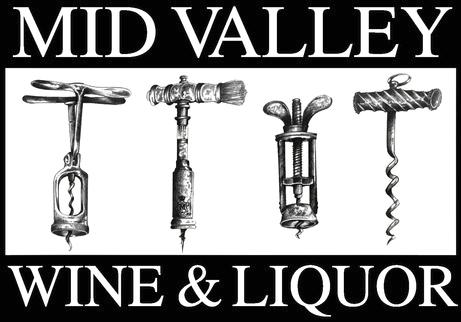





Exult O shores, and ring O bells!
But I with mournful tread, Walk the deck my Captain lies, Fallen cold and dead.
From “O Captain! My Captain!” by Walt Whitman
The casket was on the big screened porch, his body interred within. It was a simple and elegant casket, not professional but well-made. Built of pine and stained golden brown, the sides of the hinged lid rose and then made a 45-degree turn, and again to make a flat top. A student had built the casket at his request decades before.
Sitting beside the casket on the porch I thought for a moment about why it looked strange and I realized it was the ceramic knob on the edge of the lid. It gave the impression of a kitchen cabinet with a door that one would open and close frequently, rather than just once, in the manner of a casket. I recalled that the man whose body was inside had already made use of the vessel. He often practiced lying in it in the tradition of his namesake and hero, Saint Francis.
The body inside belonged to my teacher and spiritual father, a man named Frank Crocitto. I met Frank when I was 16. Barely a day passed that I didn’t see him for the next 15 years.




Frank was a teacher in the inner work tradition of George Ivanovitch Gurdjieff. I first met him because my mother had been attending his classes and the changes in her bearing and demeanor were undeniable. I noticed that her movements had become more deliberate and attentive as she moved about the house, and that she seemed to be making an effort to listen. On this basis I agreed to attend his classes, despite all the teenage instincts against doing something one’s mother recommends.
Frank’s teaching was elegant in its simplicity. Ideas about psychology and cosmology seemed to emerge from a boundless spring, and yet they all seemed to be of a piece, held in constellation by a powerful unifying principle. Mostly I was impressed with Frank’s presence and person. He struck me as a rare example of someone who practiced what he preached.
Listening to Frank speak was a real pleasure, in part because his Brooklyn-tinged voice seemed to resonate in every cavity of his body. He was like a human sounding board. And he delivered his lectures artfully, extemporaneously but always with a central point, a clear arc of exposition, and in every case the talks concluded with an exercise or task meant to elucidate the teaching.
The practice was both simple and incredibly difficult. A few examples out of hundreds: Stop periodically and bring attention to your senses; try to retain this inner awareness in the midst of activity; do one thing at a time; be the observer in yourself; strive to have your attention directed rather than captured; be of service; remember that you are never the problem.
Together with Frank’s artful teaching was the vortex of activity and effort that surrounded him like a whirlwind. We gathered for meetings, intensive weekends of physical work digging, building, painting—all while attempting inner exercises and meditation. He had been in theater in his previous life and adapted or wrote and directed plays that we worked on as actors, stagehands, and set builders.




We mounted a play called “Let Man Live” by Swedish author Pär Lagerkvist. The characters were historic martyrs—Socrates, Christ, Paolo and Francesca, the victim of a South Carolina lynching, Joan of Arc, Giordano Bruno. Frank had thrown his back out and had to be carried into the theater for rehearsals. He was clearly in pain, and directed the actors while lying flat on a beach chair. I was in awe at the palpable force of creative will emanating from his helpless form.


In the late `80s, Frank and our group bought a property on the edge of New Paltz. It had been Sunnyside Poultry Farm, and once we moved onto the property the name became simply Sunnyside. It was a 13-acre property with several houses, barns, and outbuildings, many on the cusp of dereliction. From among perhaps 100 students, 12 of us joined Frank and became settlers.
Sunnyside was a new chapter, with continuous work repairing, renovating, and improving the property. In one case, we dug out the basement of the old barn, jackhammering rock-hard Rosendale cement late into every evening so a new foundation could be laid under the massive structure.
Following Frank’s audacious example, students began many projects within the context of the work including a bookstore, a children’s school, and a magazine. I recall the conversation with Frank when I told him I wanted to start Chronogram.
“Yes!” he said with enthusiasm, “But only on one condition. Don’t quit.”
Frank Anthony Crocitto, born July 7, 1937, died March 27, 2024, was a teacher, artist, poet, playwright, director, and in his waning years became proficient with a lasso. Frank was the spiritual director of Discovery Institute and contributed dozens of columns to Chronogram in the early issues of the magazine, many of which were collected in the book Insight is Better Than Ice Cream and a few are still available on the Chronogram website



Summer’s the best season for celebrating indoors and out, and great food is why we stock the best selection of kitchen tools anywhere in the area— More than any other store offers. It’s why more chefs come to Warren Kitchen & Cutlery for their kitchen tools! For them, it’s personal and it’s also the reason our customers keep coming back.
We carry and stock The Hudson Valley’s best selection of fine cookware, cutlery, appliances and accessories— Period! Where else would anyone shop for anything for their kitchen?
• Unique and rare knives from around the world
• Cookware, bakeware and barware
• Great gifts, and gift wrapping available















Iceland wasn’t my idea. If I’m vacationing in late winter, trying to bridge that last chilly chasm of March, my thoughts tend toward the Caribbean, where Lee Anne and I have spent many warm, sunny hours doing nothing much at all on beaches in the Bahamas, Puerto Rico, and the British Virgin Islands. But we didn’t have anything planned this year, so when Amanda asked us if we wanted to join her merry band heading to Iceland, Lee Anne and I were in. Given the direct flights out of Stewart Airport, it seemed like everyone I knew had been to Iceland or planned on going. And besides, I’ve always wanted to meet Bjork.
So, like any good 20th-century tourist, I went to the bookstore and bought a Lonely Planet guidebook to Iceland and painstakingly mapped out a jam-packed itinerary for our four-day whirlwind tour of the land of fire and ice. It was a near-perfect (IMHO) survey of all the natural wonders within two hours of Reykjavik, with time left to explore the city. And then, just for funsies, I fed a prompt to ChatGPT asking it to come up with a similar itinerary. It produced a moreperfect survey of tourist attractions. I shared ChatGPT’s findings with my fellow travelers and we prepared to leave on Wednesday evening of Holy Week.
Play is the name of the low-cost Icelandic carrier that flies out of Stewart. How low cost, you ask? So low-cost that there was no WiFi on the five-hour redeye flight. I had to read a book(!) and then content myself with admiring the Northern Lights out the window for the last half hour of the flight.
Once we made it through customs, we headed out to pick up our van, which was on the far side of a very windy parking lot. I didn’t have an anemometer (look it up) on me, but let’s say the wind speed was 60 kilometers per hour—we were in metric territory, after all.
This is not to say that the vindur (wind) was limited to the parking lot. It turns out, the whole of Iceland is a relentlessly windy place. Which not one person with whom I spoke to about traveling there warned me of. Although when I texted my friend Lynn about it, she replied, “Oh yeah, forgot about that. It was windy AF.” Lonely Planet Iceland makes no mention of it either. Not even ChatGPT gave me the heads-up.
Unsurprisingly, there are over 130 words for wind in Icelandic. Here are just a few. Hvassvidri:

gale. Allhvass: moderate gale. Farvidri: hurricanestrength. Wherever we went, from the foss (waterfall) to the jokull (glacier) to the hofudborg (capital city), it was blowing somewhere between a hvassvidri and an allhvass. Which led me to suspect that the reason the streets of Reykjavik were as clean as those of a Canadian city had to do with the wind. There’s a chain-link fence somewhere on the edge of Reykjavik just pasted with refuse. On the one day a year the wind isn’t blowing, the entire city comes out in communal celebration to pick the trash off the fence, eat svid (boiled sheep’s head), and drink Brennivin (schnapps made from potato and caraway seeds).
A real parti
After a restorative midmorning nap at our Airbnb in downtown Reykjavik to soothe the red-eye jitters, I awoke to hear Amanda say, nonplussed, “There are Spaniards in the hot tub.” Looking out the window, I did indeed spy a couple in the backyard enjoying the bubbly water. I had to take Amanda’s word on the Spanish bit as their passports weren’t visible and they weren’t eating paella. But it seems that
Brian K. Mahoneyour Airbnb, listed as having a hot tub, failed to mention it was a communal hot tub, sometimes occupied by Spaniards.
The other thing I could see from my window: An Easter egg hunt taking place in the yard next door, children tearing ass rooting out the eggs and parents standing around, chatting and drinking like it was a summer afternoon garden party even thought it was late March, two degrees Celsius, and the wind was a touch hvassvidri. The Icelanders remained unfazed. (It wasn’t shocking to learn that Iceland was settled by the Norse, who arrived in open boats in the 9th century. The country is the only place colonized by Europeans where no Indigenous people were displaced.)
We went out for lunch and landed at a traditional Icelandic restaurant across the square from the Hallgrimskirkja, the church that dominates the city’s skyline. Among other delicacies, I ordered hakarl—fermented shark, which Anthony Bourdain referred to as “the single worst, most disgusting and terrible tasting thing” he had ever eaten. It smelled of feral animal urine and gasoline with a hint of silage. There was a lot that had happened to this shark since it died to impart this complexity of flavor to it, and none of it was good. The texture was slightly chewy, a little tripe-ish in its flex, but that was mostly lost in the aroma of a raccoon pissing in my mouth while I huffed a five-gallon can of unleaded on a compost heap. The one thing I’ll say in defense of hakarl it’s served with Brennivin.
We spent the next three days traveling from geyser to waterfall to glacier to black sand beach, being blown off our feet by varieties of vindur in the astonishing geological theme park that is Iceland. We also saw a very sad film about Iceland’s jokulls at the Perlan museum. You might want to hurry if you want to see a glacier.
In sum, here’s my capsule review of Iceland: Easy to get to yet suitably foreign, food was consistently good across the board (the hakarl was a selfinflicted wound), cute road signs, clean streets, everyone speaks English, massive landscapes for days, geothermal pools are good for hangovers, and active volcanoes are cool. Iceland packs a wallop. Four out of five stars, the one-star deduction for the wind, which, to be honest, felt personal after a while. You think it’s a bug at first, but it turns out to be a feature. If anyone from the Icelandic Tourism Board is reading this: You might want to think about throttling back the wind a bit. Just saying.

Since at least the Neolithic period, humans have used fermentation to make the most of what the land has to offer. Whether turning milk into yogurt, or fruits and grains into alcohol, fermenters have long harnessed the preservative and transformative powers of fermentation to produce creative expressions of what is locally and seasonally available. While disparate industries have arisen around particular alcoholic ferments—wine, cider, beer, and the like—many craft alcohol producers choose to experiment along and across the boundaries between them. In doing so, they challenge popular expectations around what these beverages can look and taste like, and keep their projects responsive to the local agriculture and climate. Put simply, co-fermentation is the process of fermenting multiple things at once, together. Cofermentation as a practice is nothing new. Indeed, the very first alcohols were likely co-ferments of grain, fruit, and honey. Co-ferments may fit neatly into traditional categories, such as a wine fermented from multiple grape varietals, a cider
fermented from multiple apple varietals. Beers, too, have historically been co-fermented with seasonal fruit to add flavor, color, or complexity. But co-fermentation can also upset these categories, creating hybridized beverages that muddle our preconceived ideas about what wine, cider, and beer can be. In recent years, as small alcohol producers grapple with how to keep their projects tied to the land, many have begun to approach co-fermentation with a renewed vigor, and with a profound spirit of experimentation. Many producers in the Hudson Valley are participating in this growing trend, using ageold methodologies to create novel ferments, and breaking down barriers as they go.
Left Bank Ciders, based in Catskill, has been co-fermenting since their operation began in 2019. Using a base of apple juice steeped with whole fruits, their team has made a wide array of co-fermented concoctions, including plum, peach, and cherry ciders, as well as cherry and
black currant meads. Limiting their ingredients to what is locally and seasonally available, they simultaneously ensure that their ferments are distinct to the region and minimize the environmental impact of their work. Local ingredients travel less far from the farm to the fermentation vessel.
Likewise, fermentation projects offer an opportunity for farms to offload less cosmetically attractive inventory. Co-fermentation across varietals and species amplifies this effect, since Left Bank can think more fluidly about what to ferment, depending on what is most readily available. Cofounder and cidermaker Tim Graham explains that they get most of their fruit from Mead Orchard in Red Hook. “Often, they have ‘seconds’ fruit they can’t sell at market because of some visual issue, a bruise or cut, which we are happy to use for our co-ferments. We are lucky to be able to help farms use this otherwise unsellable fruit and to help eliminate waste when we can!”
“Co-ferments are definitely having a moment and really bending the rigid concepts of wine, cider,


beer in new directions,” Graham explains. “I think that climate change is a big part of the equation, and making more resilient drinks, using what we have on hand, and experimentation are all part of what makes co-fermenting interesting. Instead of making another single varietal wine that has to be grown in a super specific way, we can look to what is already growing, and thriving right here, right now. I think we can make some amazing beverages without having to force things to grow that might not fit our climate in the first place.”
One thing that grows quite well in the Hudson Valley is apples, and Left Bank is hardly the only cidery in the area making use of their local availability. In New Paltz, the folks at Brooklyn Cider House have been co-fermenting for about a decade, since Peter and Susan Yi first began making ciders with multiple apple varietals. However, as Richard Yi—Peter’s son and a member of the production team—explains, “In regard to using different fruits, we have only
scratched the surface. We started co-fermenting apples with strawberries grown on our farm in 2023, and those batches should be nearing release. We’re also experimenting with locally sourced blueberries, but those won’t be ready until next year.” Yi believes that “integrating other fruit at an early stage in the fermentation process creates a depth of flavor that cannot be achieved through ‘flavored’ ciders.”
Like other producers in the Hudson Valley, Brooklyn Cider House is approaching multispecies co-ferments with hopes of more fully appreciating the agricultural diversity on hand in the region, and even on their own land. Integrating new fruits into their ferments is a natural extention of their approach to cidermaking, which aims to make the most of what the local landscape has to offer.
For Matthew Sanford and his production team at Rose Hill Farm in Red Hook, sustainability is the name of the game. Rose Hill has been a
site for co-fermented experimentation since its very inception in 2018. “The impetus is really the availability of different kinds of fruit, since our farm grows many kinds of fruit, and many varieties of each. We strive for zero waste, utilizing everything we grow in some shape or form,” their team explains. “Cider is wine” is a maxim that echoes throughout Rose Hill’s production space and tasting room, as Sanford educates his clientele about the methodological and historical slippage between these seemingly disparate beverages. Yeast eats sugar and produces alcohol the same way regardless of fruit species, so all fruit wines are, in a sense, of the same broader category of ferments. By educating their customer base in this way, Rose Hill’s team hopes to “blur the lines between wine and cider, and to expand people’s understanding of what is possible.” Doing so might lend legitimacy to the co-fermented projects that are Rose Hill’s bread and butter, and encourage both consumers and producers to embrace experimentation in the fermentation vessel.




Fine Dining in a Historic Tavern and Former Speakeasy
Creative New American Cuisine using Classic French Techniques Serious Food in a Relaxed, Historic Setting Open Mother’s Day, Sunday, May 12th, noon-6pm
N ORTH P LANK ROAD TAVERN
30 Plank Rd, Newburgh, NY · (Just off of 9W at I-84)
845-562-5031 · northplankroadtavern.com
Open Wednesday–Saturday, 4:30–9pm for dinner. Happy Hour 4:30–6 pm













Co-fermentation across fruit species is a powerful framework for upsetting long-held cultural ideas around what wine, cider, or other ferments can be. The fermenters at Rose Hill, Left Bank, and Brooklyn Cider House are helping to flatten the distinctions around different kinds of fruit wine, which have historically pigeonholed alcohol producers, fruits, and ferments into narrow, often ill-fitting definitions. In many cases, conventions, industry standards, and even licensing regulations have precluded producers from using everything at their disposal and (co)fermenting with total creative freedom.
The acrobatics and nuances of licensing are well within the wheelhouse of Michael Renganeschi of Hudson Valley Brewery, who is working in a similar vein. Since the brewery’s opening in 2017, Renganeschi and his team have accumulated no fewer than five licenses—a collection that allows them to produce the beer, cider, grape wine, and myriad unusual fruit wines, coferments, and curiosities within their repertoire. While all the beer is brewed at their brewery and taproom site in Beacon, they maintain another facility in Poughkeepsie, where their more eccentric, wild-fermented experiments are made. For Renganeschi, beer has always been just one tributary feeding his larger passion for fermentation. Working across categories of ferments allows him to engage more holistically with the ingredients at his disposal.
To make Kinds of Light, one of the brewery’s farmhouse ales, Renganeschi ferments merlot grapes for four weeks before pulling off the fermented juice and adding an aged farmhouse beer on top of the spent skins, stems, and seeds, which kickstarts a refermentation of the beer and grape pomace together. The result is a hybridized beer-wine beverage that


is emblematic of Hudson Valley Brewery’s broader practice. They might do the same thing with peaches instead of grapes, with cider instead of beer. “I think about it as a really sustainable approach to using fruit,” Renganeschi explains, “because you’re not just buying the peaches, pressing them out, discarding half of it and trying to get some extracted version into one beer. You’re using fruit in a way that maybe has slightly diminishing returns, but you’re adding nuance and depth to products for sometimes a whole year.”
The breadth and depth of available agriculture and native fruits in the Hudson Valley makes the region particularly ripe for co-fermented projects. Without a singular exceptional fruit or varietal dominating the local landscape, Hudson Valley producers have more space to experiment with what is on hand. “I see a lot of younger producers in the Hudson Valley really looking at and taking advantage of what is growing here. We have really good stone fruit, and pretty good grapes, and really good apples, and a really diverse range of herb farmers and flower farmers,” Renganeschi explains. Referring to the region’s “plethora of agriculture,” he goes on: “We’re, a lot more keen to not be boxed in by one thing we’re doing, because it’s a lot more exciting to just take what comes to you and try to work with it.”
While co-ferments offer a framework for creative expression in the production room, they also offer a more flexible way forward for alcohol producers hoping to keep their projects grounded in local agriculture, paying heed to seasonality and sustainability. As climate change escalates, becoming an increasingly relevant concern in the craft alcohol space, it will only grow more important to work creatively with what is locally available. Co-ferments and boundary-crossing fermentation projects more broadly will be an important part of this story, just as they have been since the very beginning.









www.HudsonValleyBounty.com

1.
49.
restoration.
50. Roscoe Beer Company 145 Rockland Road, Roscoe
51. Rough Cut Brewing 5945 Route 44 55, Kerhonkson Roughcutbrewing.com (845) 626-9838 Kerhonkson’s original brewery and restaurant, serving a wide & ever-growing beer selection and tasty foods on the Shawangunk Ridge.
52. Rushing Duck Brewing Company 2 Greycourt Avenue, Chester
53. Russian Mule Brewing Company 1465 Denning Road, Claryville
54. Shrewd Fox Brewery 552 Route 55, Eldred
55. Sloop Brewing Co. 755 East Drive, Suite 106 Hopewell Junction
56. Slow Fox Farm 41 Lake Drive, Rhinebeck
57. Suarez Family Brewery 2278 Route 9, Livingston
58. Subversive Malting & Brewing 96 West Bridge Street, Catskill
59. The Tasting Lab 4856 State Route 81, Greenville
60. Tin Barn Brewing 62 Kings Highway Bypass, Chester
61. Union Street Brewing Co. 716 Union Street, Hudson Unionstreetbrewing.com (518) 822-1133 Craft brewery with a large tap room, event spaces and outdoor beer garden located in the heart of historic Hudson, NY in the middle of Hudson Valley.
62. Upper Depot Brewing Co. 708 State Street, Hudson Upperdepot.com • (518) 859-9114 Locally owned and operated, this taproom features up to 12 craft beers rotating seasonally and made fresh in house by head brewer, Aaron Maas. With a wraparound deck reminiscent of a train platform, there’s plenty of room for outdoor seating.
63. Upward Brewing Company 171 Main Street, Livingston Manor
64. Vosburgh Brewing Company And Orchards 1065 County Route 19, Elizaville
65. Wandering Star Brewing Co. LLC 11 Gifford Street, Pittsfield
66. West Kill Brewing 2173 Spruceton Road, West Kill
67. Woodstock Brewing 5581 Route 28, Phoenicia
68. Yard Owl Craft Brewery Inc.
19 Osprey Lane, Suite 1, Gardiner
3. Annandale Cidery
8 Davis Way, Annandale-on-Hudson
8. Fishkill Farms
9 Fishkill Farm Road, Hopewell
Cyder &
Chatham
12. Greenpoint Cidery 4161 Route 9, Hudson
13. Hardscrabble Cider 130 Hardscrabble Road, North Salem
14. Heartsby True Cider
256 Jefferson Heights, Catskill 15. Hilltop Orchards 508 Canaan Road, Richmond
16. Hudson Valley Farmhouse Cider At The Stone Ridge Orchard Tasting Room 3012 NY-213, Stone Ridge Hudsonvalleyfarmhousecider.com (845) 687-2587
Stone Ridge Orchard hosts the Hudson Valley Farmhouse Cider’s farm bar with hard ciders for tasting and wood-fired pizza available.
17. Hurd’s Farm 2187 NYS Route 32, Modena
18. Kelder’s Farm 5755 Route 209, Kerhonkson
19. Kettleborough Cider House
277 NY-208, New Paltz
20. Kings Highway Cider
Cooper Road, Millerton 21. Left Bank Ciders
Water Street, Catskill
Little Apple Cidery
Orchard Lane, Hillsdale
Metal House Cider
Esopus Avenue, Ulster Park
Orchard Hill Cider Mill
Soons Circle,
1. Dassai Blue 5 Saint Andrew Road, Hyde Park Dassai.com • info@dassai.com The new state-of-the-art sake brewery is open for tours & tastings, bottles sales and walk-ins! Learn about sake making and taste the delicious sake.
Hillrock Spirits 408 Pooles Hill Road, Ancram Hillrockdistillery.com • (518) 329-1023 Hillrock crafts award-winning, terroir-driven whiskeys from its own grain, grown sustainably using organic principles and copper pot-distilled in small batches.
19. Hudson House & Distillery 1835 Route 9W, West Park Thehudsonhouseny.com (845) 834-6007
A destination distillery like no other in the heart of Hudson Valley.
20. Hudson Valley Distillers 1727 Route 9, Germantown
21. Jayne Street Distilling Co. 41 Jayne Street, Florida
22. Klocke Estate 2554 County Route 27, Claverack
23. Liquid Fables 578 Main Street, Beacon
24. Olde York Farm 284 State Route 23, Claverack
25. Orange County Distillery 19B Maloney Lane, Goshen
26. Shady Knoll Orchards & Distillery 37 Brush Hill Road, Millbrook Shadyknolldistillery.com (267) 977-8137
A family farm distillery that grows apples to make Shady Knoll Apple Brandy and Pommeau, and grains to make their Shady Knoll Whiskeys-tours/tastings by appointment.
27. Silver Bear Distillery 63 Flansburg Avenue, Dalton shadyknolldistillery.com
28. Silver Brothers Spirits Company 155 Shaker Museum Road Old Chatham
29. Speakeasy Motors Whiskey Co. At Liquid Mercantile Distillery 174 Hardenburgh Road, Pine Bush
30. Spirits Lab Distilling Company 105 Ann Street, Newburgh
31. Taconic Distillery 215 Bowen Road, Stanfordville
32. Tenmile Distillery 78 Sinpatch Road, Wassaic
33. The Distillery At Greylock Works 506 State Road, North Adams
34. Tuthilltown Spirits 14 Grist Mill Lane, Gardiner Hudsonwhiskey.com • (845) 419-2964
NY’s first distillery since prohibition –come for a guided tour, sample from their ever-changing menu of craft cocktails, explore their beautiful grounds or simply enjoy a whiskey flight including NY’s first Bourbon, all crafted onsite from NY grain.
35. Vale Fox Distillery 619 Noxon Road, Poughkeepsie
36. Warwick Valley Distillery 114 Little York Road, Warwick

This almost shouldn’t have happened, yet here we are,” says Charles Ferri. After almost a decade of work, Ferri and his business partner Paul Seres opened their longawaited Ulster County destination distillery, Hudson House & Distillery, in 2021.
After a few years of planning, it was the West Park property that officially kicked the hospitality veterans’ dream into high gear. With over 27 acres, sweeping Hudson River vistas, and an impressive 28,000 combined square feet of space, it had everything they had been dreaming of in a location. “It was like we were casting a movie, and we needed to find our leading lady,” Seres explains. “We found the beauty of our leading lady right here.”
The property’s original manor house, an elegant 1800s Italian Renaissance Revival-style villa, was built by Archibald Russell in the 1850s. In the 1930s, a four-story brick monastery was added by the Congregation of Christian Brothers. In 2015, Ferri and Seres purchased the property, which had fallen into disrepair after the Congregation declared bankruptcy. They embarked on years of planning and gut renovations with the goal to transform the two buildings into a distillery, restaurant, event venue, and boutique hotel that honored their historic character.
Covid-related shortages ultimately led the
business partners to do most of the work themselves, and the unexpected passing of their head distiller and local craft beverage royalty, Gable Erenzo, led to a crash course in learning how to assemble their massive German-made copper stills. “Everything that was thrown in front of us just made us want this more,” says Seres.
Today, visitors can finally experience the history of the property and all the work it took to open it to the public for the first time. Hudson House’s Black Creek small batch bourbons and ryes and Altair vodka are all crafted on-site using limestone-softened water from the property’s own artesian well. A New York gin, with notes of juniper, jasmine, and rose, will be released this summer.
Thursday through Sunday, guests can book a tour and private tasting, reserve a table at the restaurant, or stop by for a drink complete with panoramic views of the river and verdant valley below from the 4,000-square-foot deck. The bar specializes in curated cocktails whose mixers play well with the spirits, like a house-made bourbon maple syrup in the Old Fashioned.
“Food at distilleries has historically been a joke, so we wanted to step it up,” Ferri says. “Chef Max Renny brings a passion for food like we bring a passion for the distillery.” The menu is comforting, yet refined, featuring dishes such as a mezze
platter, a Hudson House burger, and a 10-ounce New York strip.
Events at Hudson House are steeped in historic charm, with dining rooms and parlors that feature original parquet floors, vintage chandeliers, and elegant fireplaces aplenty. Pocket doors throughout the manor house close off rooms for private dinners, and bigger get-togethers occur on the 300-person riverview deck or inside the former monastery’s 5,000-square-foot, brick-andhardwood ballroom. Downstairs is a speakeasy with a view into the distillery, a favorite for bridegrooms and their entourage. A bridal suite on the second floor is sunny and bright, perfect for day-of preparations.
Future plans include nine rooms in the manor house and 15 in the former monastery for overnight guests—the last stage of the property’s multi-year transformation. “Anyone can pour a spirit in a glass in any old bar,” Seres says.
“Finding Hudson House created the opportunity to tell our story and offer a unique experience for our guests.”
Hudson House & Distillery 1835 Route 9W, West Park (845) 834-6007
Thehudsonhouseny.com

RMV Cellars
112 Burroughs Drive, West Park Redmaplevineyard.com/rmvcellars
After a decade of success running their farm-to-table wedding venue, Red Maple Vineyard owners Liz and Gary Stone and their crew decided they wanted to create a place on the property where the public would always be welcome on weekends.
Last fall, the team opened RMV Cellars, a brand new tap and tasting room, restaurant, and production space for their housemade wines and recently purchased Great Life Brewing, a favorite Kingston craft brewery now at home at RMV. True to the venue’s local-first ethos, much of the wood for the spacious new building— located on the other side of the property from the wedding venue—as well as its furniture were sourced and milled on-site.
Seminary Hill Orchard & Cidery
43 Wagner Lane, Callicoon (845) 887-4056 Seminaryhill.co
Seminary Hill in Callicoon is the world’s first Passive House-certified cidery, and now it has earned its organic certification from the Northeast Organic Farming Association of New York. “Organic certification takes enormous effort,” says Doug Doetsch, owner of Seminary Hill. “We’re proud to offer ciders from graft to glass and contribute to New York’s position as the leading cider state in the country.”
Seminary Hill’s organic 12-acre orchard features 1,500 trees that produce 60 varieties of apples and Perry pears. Where to begin a tasting journey?
Start with Cackling Hen, an easy-drinking, semi-sweet cider named after Callicoon, an old Dutch word meaning wild turkey. Tom’s Beard, with its tropical fruit notes and bright acidity, is a choice pick for the warm-weather season ahead. Having earned a gold Cidercraft medal and a silver Glintcap medal, Hen’s Teeth, a fortified apple dessert wine, has taken center stage in Seminary Hill’s cocktail program, starring in riffs on classics such as the Old Fashioned and Manhattan. Attend a weekly tour and tasting and explore the organic orchard, get a behind-the-scenes look at the cidery, and take in the views from the Tasting Room during a guided tasting. Enjoy a full menu by Executive Chef Jack Tippet, where everything is designed to pair with a cider flight: five pours at 2.5 oz each, from dry to semi-sweet.
Seminary Hill offers nationwide cider shipping, but to experience authentic Catskills heritage firsthand, check into the Boarding House (outfitted by local studio Homestedt) and spend a day or two in Callicoon.
“It’s been so much fun since we opened,” says Gary. “Madi’s awardwinning wines and Cody’s award-winning beers are now all made on-site and available to the public every weekend. We’re lucky to have a kitchen crew made up of talented CIA graduates, including Head Chef Sara and Seth, master of the smoker and Argentinian parrillada grill.”
The locally sourced menu, including seasonal items from the farm and eggs from their chickens, also features wood-fired pizza and a variety of globally influenced comfort foods. In addition to great food and drink, visitors can enjoy live music on Friday and Saturday evenings, lawn games, and a sculpture garden featuring the work of local artists. “Cellars has a really great relaxed vibe,” Gary says. “We’re so proud of our crew and excited for the summer ahead.”
Produced by Chronogram Media Branded Content Studio.


417 River Street, Troy (518) 273-2337 Brownsbrewing.com
At Brown’s Brewing Company, it’s not just about the beer and the food—it’s the experience. Rooted in a dedication to pleasing the discerning tastes of craft beer aficionados and culinary enthusiasts alike, they don’t just brew beer and cook food; they craft an immersive journey that embodies passion, creativity, and relentless pursuit of innovation. Take a journey where every sip and every bite tells a story, a story that is uniquely Brown’s Brewing Company. They celebrate the ethos of independence, urging visitors to break free from the mundane and savor the vibrant flavors that define them. Join them at the source, and embark on an adventure together.

331 Mckinstry Road, Gardiner (845) 255-4613 Whitecliffwine.com
Whitecliff has dedicated more than 30 years to finding and planting grape varieties that succeed on their site. They are dedicated to sustainability, environmentalism, and producing vegan wines to be proud of. The family-run business is celebrating 25 years in 2024. Winning more international awards than any other producer in the Hudson Valley, they are certified sustainable, and make limited release vegan wines. With two tasting rooms, one in Gardiner and one in Hudson, it’s simple to come and see why their favorite review described them as “Like visiting an unpretentious friend who is excited to teach you about wine.”
Photo by Julie Goldstone485 Lasher Road, Tivoli (845) 757-2337
Lastingjoybrewery.com
Lasting Joy crafts beers from locally sourced ingredients, served in an award-winning, glassenclosed tasting room. With five mainstay beers and an ever-evolving array of seasonal and experimental brews, Lasting Joy is a love letter to community, craftsmanship, and connection.

408 Pooles Hill Road, Ancram (518) 329-1023
Hillrockdistillery.com
Celebrating the Hudson Valley’s storied terroir, Hillrock is proud to be one of the world’s few Field-To-Glass® distilleries and the first USA distillery since Prohibition to floor-malt and hand-craft whiskey on site from estate-grown grain. Farming 850 acres sustainably, Hillrock is open daily for tours and tastings.

Apex Brewery
405 NY 17M, Monroe (845) 202-3498
Apexbrews.com
Nestled in Monroe, Apex Brewery stands as a beacon of craft beer diversity, boasting a lineup that caters to every taste bud. From hop-forward IPAs to rich stouts and crisp lagers, their offerings tantalize the senses. Patrons, a vibrant mix of locals and visitors, gather to savor the brews and share stories, fostering a tight-knit community united by a love for exceptional beer.

32 Anthony Street, Hillsdale (518) 303-8080
Roejanbrewing.com
Enjoy exceptional craft beer, hearty pub fare, and live music in an award-winning historic restoration. Prefer to sit outside? Their beer garden and patio were voted “best outdoor dining” and “best dog-friendly dining” by readers of Rural Intelligence. Raise a glass in scenic Hillsdale–and don’t forget Fido!

Shady Knoll Orchards & Distillery
37 Brush Hill Road, Millbrook (267) 977-8137
Shadyknolldistillery.com
Shady Knoll Orchards & Distillery is a family farm distillery near Millbrook. They grow their own apples and grains to create Shady Knoll Apple Brandy, Pommeau, Rye Whiskey, Single Barrel Rye Whiskey, Four Grain Whiskey, and Whiskey. They focus on producing small quantities of high-quality specialty craft distilled spirits.
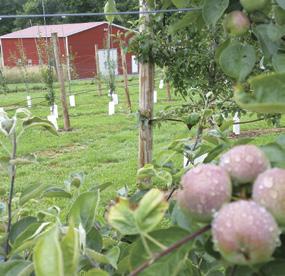
Stone Ridge Orchard
3012 Route 213, Stone Ridge (845) 687-2587
Stoneridgeorchard.com
Hudson Valley Farmhouse Cider at the Breezy Hill Orchard Tasting Room is located at Stone Ridge Orchard. Visit on weekends, Memorial Day until Thanksgiving, for cider flights, plus New York beer, wine, and cocktails. To purchase their cider please visit one of their farmers market stands or the Stone Ridge Orchard farm stand from May through December.
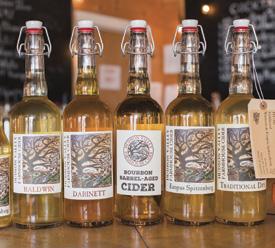
Tuthilltown Spirits
14 Grist Mill Lane, Gardiner (845) 419-2964
Hudsonwhiskey.com
Tuthilltown Spirits Distillery is New York’s first distillery since prohibition. Located in a historic grist mill from 1788 is the Visitor’s Center and Tasting Room where visitors can take a guided tour and sample the menu of distilled spirits, including New York’s first bourbon, all crafted on-site from New York grain.

Chronogram Eat.Play.Stay. Newsletter
Chronogram.com/eatplaystay
It’s time to discover more of the Hudson Valley. Get in on the most-talked-about restaurant openings, buzzworthy events, important community stories, and curated real estate listings before everyone else. Sign up for our newsletter and get digital exclusives on the region’s arts and cultural scene in your inbox each week.



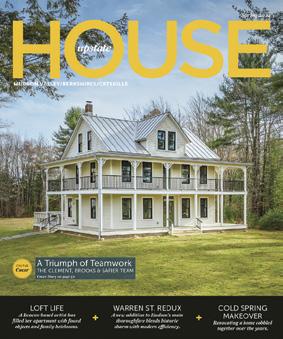



One would be forgiven for thinking that the menu at Apizza! in New Paltz would be limited to the crispy-bottomed, coal-fired pies that have made the restaurant a local mainstay since its 2021 opening. While the restaurant does serve up dozens of delicious pies every day, Apizza! has also become a quiet hit among vegan diners looking for authentic, seasonally influenced Italian specialties they can enjoy.
“It’s such an amazing vibe in the restaurant when people are comfortable with the food options,” says Adam Monteverde, who founded Apizza! with his partner, Lauren Mias. “It makes the whole experience better for everyone, and you can never make someone happy the way you do with vegan stuffed artichokes.”
A Woodstock native and CIA graduate, Monteverde worked in high-end kitchens across the country, including a Michelin-starred restaurant in San Francisco, before returning home to the Hudson Valley to open Mexican Kitchen in New Paltz in 2015. At Apizza!, Monteverde pays homage to the homey Italian dishes he grew up eating around his family table, but with a refined spin.
Monteverde’s goal is to make sure the menu has something for every diner, no matter their dietary restrictions or preferences. Local ingredients define the direction of the menu, with produce from Story Farm in Catskill making an appearance in several dishes each week. Many dishes pass through the impressive coal-fired brick oven at the center of the restaurant. The distinctive texture and flavor is a large part of what has made other coal-oven pizzerias, including Grimaldi’s and Lombardi’s in New York City and Frank Pepe’s and Sally’s Apizza in New Haven, so popular.
Regularly rotating vegan options include the aforementioned braised stuffed artichokes with garlic, parsley, lemon, and housemade breadcrumbs; rosemaryroasted delicata squash with pomegranate seeds; creamy escarole and white bean soup; and pasta fagioli, the traditional Italian pasta and bean stew. Craving a slice of ‘za? Vegan cheese is available at no extra charge.
Monteverde also knows that the entire dessert section of Italian restaurant menus is often off-limits for vegan diners, so he always makes sure that there’s an option that is as equally dairy-free as it is delicious. A particularly popular dessert is the white wine-poached pears, an updated riff on an old Italian recipe.
No matter what dishes land on the table, rotating daily house cocktails and wines by the carafe always match what’s on the menu. Medium-bodied, Central Italian classics like Montepulciano and volcanic Sicilian varieties like Etna Rosso and Etna Bianco anchor the list and pair well with a diversity of dishes, while a few expertly curated natural wines are always available to lend a bit of fun flair to any meal.
Apizza!
121 Main Street New Paltz (845) 419-2744
Coalovenpizza.org
Produced by Chronogram Media Branded Content Studio.
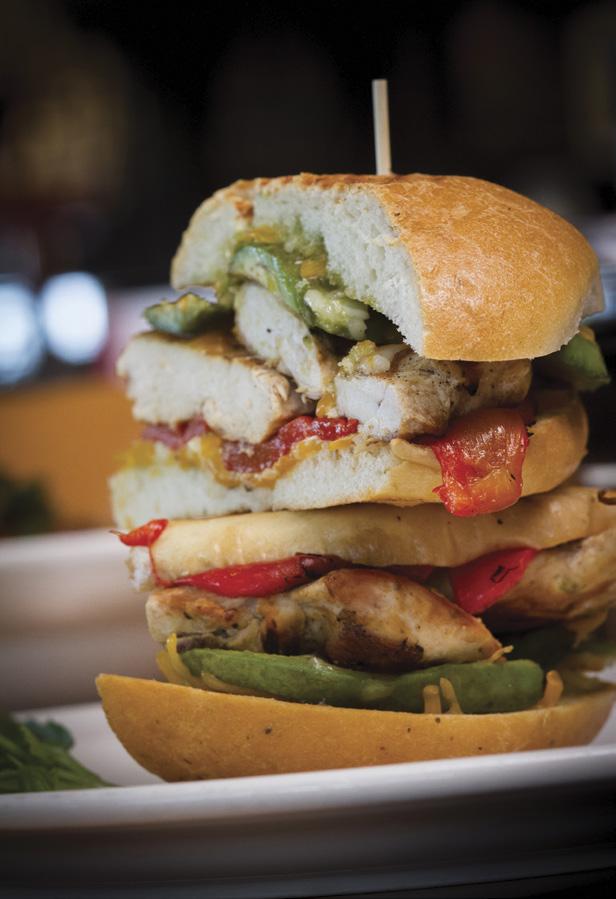
Daily Planet Diner
1202 State Rte 55, LaGrangeville (845) 452-0110 Dailyplanetdiner.com
Red Line Diner
588 US 9, Fishkill (845) 765-8401 Dineatredline.com
At first glance the menus may look familiar, with colorful laminated pages filled with classic comfort food, but Roseanne Vanikiotis wants the Hudson Valley to understand that diner fare has kept up with the times.
“We’re still the place to grab a burger and a shake, but these days it’s Kobe beef and locally sourced ice cream,” she says. “Latte instead of regular coffee? We’ve got you. We’ve been doing this 42 years, seven days a week. My brother-in-law graduated from the CIA, and he, my husband Teddy and my nephew Nick are all obsessed. They inspect every piece of lettuce that comes into the kitchen. Everything has to be the freshest and best.”
Her family business, the Vanikiotis Group, owns the Red Line Diner in Fishkill and the Daily Planet in LaGrangeville. Vanikiotis—who cherishes the memory of customers knitting baby gifts for her daughter 37 years ago—passionately agrees with a letter to the editor in New York magazine in 2017 in which a placemaking expert called diners an “invaluable third place” that transcend every known divide.
“You’ll have a table of people in PJs and flip flops next to one fresh from a black tie wedding next to the regular who’s asked for Karen’s section because Karen knows they don’t want their OJ chilled and they want to ask how her sister’s doing,” she says. “It’s just a completely different dynamic from a regular restaurant.”












1. 2279 ROUTE 9
Livingston, NY. 4BR. 2.0 Baths. $1.2M. Web ID 22900427. Nancy Felcetto 917-626-6755
2. 17 SOUTH 6TH STREET




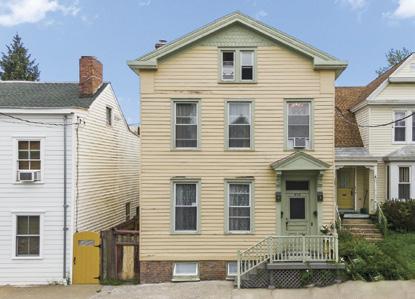


Hudson, NY. 3BR. 1.5 Baths. $7K/month. Web ID 22644458. Owen Davidson 917-783-2009
3. 53 CRESCENT DRIVE
Hillsdale, NY. 3BR. 2.0 Baths. $695K. Web ID 22919457. Suzanne Wright-Kelly 914-456-5443
4. 2215 BEAVERKILL ROAD
Livingston Manor, NY. 4BR. 3.5 Baths. $525K. Web ID 22712924. Kathleen Sloane 212-906-9258

5. 1 BOG HOLLOW ROAD
Wassaic, NY. 6BR. 7.0 Baths. $8.0M. Web ID 22704006. Joseph Lorino 212-452-4513
6. STATE ROUTE 97
Narrowsburg, NY. 370 Acres. $2.95M. Web ID 22727685. Richard Orenstein 212-381-4248 Felicia De Chabris 212-381-6513
7. 450 UNION STREET
Hudson, NY. 6BR. 3.0 Baths. $949K. Web ID 22637649. Jean Stoler 518-755-4298



8. BROWER HILL ROAD
Accord, NY. 150 Acres. $625K. Web ID 22692757. Kathleen Sloane 212-906-9258

Sitting in the heart of Uptown Kingston, parts of Helen and Tim Atkinson’s home date from as far back as Colonial times. The site’s original Saltbox was burned down during Britain’s siege of Kingston. The original basement and foundation remain, however, and a three-story Greek Revival was built over the foundation in 1840. Two Victorian additions were built during the 19th century. “This house definitely has its own character,” says Helen. “It turns up surprises—old keys, old photographs. The attic and basement are each like a whole different, weird realm.”
The first night Helen Atkinson spent alone in her new home at the corner of Fair and St. James streets she saw a ghost. “I had this vivid, near-waking dream that a woman in Edwardian clothes marched straight through the hedge bordering our side yard, through the porch door, up the stairs, and stood very sternly at the bottom of my bed and demanded to know what I was doing in the house,” says Atkinson. It was 2013 and Atkinson and her husband Tim had just moved into the three-story, 1840 Greek Revival layered with resplendent Victorian additions. “In the dream, I gave some account of myself that appeared to satisfy her,” says Atkinson. “She harrumphed, nodded, and went back down the stairs and left.”
The ghost might have been more satisfied if Helen had been more candid with her answer: Really, she just wanted somewhere to throw a good party. “I hosted my first dinner party when I was 13,” says Helen, an editor and journalist. “It ’s pretty much my favorite way to spend an evening.” The 4,300-square-foot home—then a bit more shabby
A Couple Restores a Historic Uptown Kingston Home
By Mary Angeles Armstrong
than chic—seemed built for such an aspiration. Sitting at a corner where the tram used to pass by, the sprightly space invites conviviality. It ’s not just the layout, which flows from the ballroom-like parlor into a sitting room and library then back to a Gothic Victorian dining room; it ’s also the heart-of-Kingston setting, where neighbors have been stopping by for generations and even passing strangers are inspired to strike up a conversation and sometimes become friends.
In the decade since moving in, the Atkinsons have fulfilled their original mission, reviving the home for 21st-century gatherings and recovering its spirit (and uncovering the identity of Atkinson’s spirit visitor). Their initial hunch about the home proved correct— while the surrounding neighborhood has changed around it, the home remains timeless: “It was just made for parties,” says Helen.
My family threw lots of parties here,” says John Ellis, who grew up in the house and still lives nearby. “Our extended family lived within a few blocks, so we’d have all the holiday parties in the dining room. My
parents threw cocktail parties in the front parlor, where neighbors would tell stories of growing up in the area.” Ellis’s great-grandfather, Griffin Hart, was a Tivoli native who fought in the Civil War. After being wounded at the Battle of Chancellorsville, Hart recuperated at Chestnut Hill in Pennsylvania, where he met Ellis’s great-grandmother, a nurse, before returning to the Hudson Valley to open a dry goods store.
When Hart bought the family house in 1892, it already had a considerable history. The original home—a Colonial saltbox that was destroyed during the 1777 burning of Kingston—was rebuilt in 1840 as a three-story Greek Revival from the saltbox foundation. “ The 1840 house included the front parlor and a back room as well as the stairwell going to the bedrooms upstairs,” says Ellis. “ There was also a back staircase leading to an attic room on the third floor.” In 1860, a Victorian-style addition included a second living room downstairs and two more bedrooms on the second floor.
It’s possible Hart sensed the home’s potential as a gathering space, because soon after moving in he built an oversized dining room at the back of the home. With ample space for a long dining table, the room features
The home was owned by four generations of the local GrantEllis family who added the Gothic Victorian dining room in 1892. The oak-trimmed room includes a built-in seating area and an oak fireplace mantel carved with a lion motif. John Ellis, who grew up in the home and still lives nearby, recalls the room filled with extended family on every holiday of his childhood. “The built-in dining area overlooking the street was the kid’s table,” he says.






























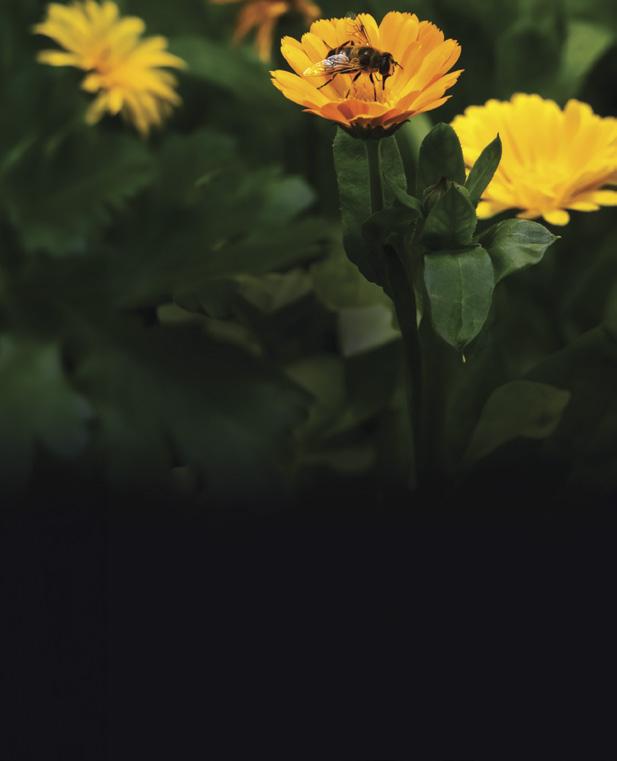














The home was large enough for multiple generations as well as extended family living together and Ellis grew up with his grandfather living on the first floor. His parents eventually combined two rooms at the back of the home to create a rambling modern kitchen. Right outside the kitchen, the home’s original washhouse is still standing.
carved oak walls and mantle, as well as an iron fireplace insert carved with a dragon motif. There was even a carved, built-in corner nook Ellis remembers as “the kids table.”
The space would be the site of family gatherings for the following century. Hart also added additional kitchen space and two more bedrooms upstairs for a total of six.
The home was passed down through Hart ’s daughter ’ s line to Ellis’s grandparents, who lived downstairs. “My grandmother had tuberculosis and so she’d sit on the side porch to get the fresh air,” says Ellis. “She was very social, and neighbors would stop by constantly and sit in the side yard to chat.” Meanwhile, Ellis’s parents and sister lived on the second floor, where they ’d converted a back room into a small kitchen and a front bedroom into their living room. Ellis’s grandmother died shortly before he was born, and when his grandfather passed away the family moved downstairs. They expanded the back kitchen and converted part of the 1860 Victorian sitting room into a study for Ellis’s father, who was an expert on Persian carpets.
Ellis inherited the home when his parents passed away and then lived there with his wife Judith for a few years. “But I’d always had a secret desire to live in the woods,” he says. He realized he was ready to move on and began searching for the right custodians to keep the home’s spirit alive. That ’s when the Atkinsons stepped in.
The couple, who are both from the United Kingdom, met in New York City and began coming upstate in 2005 to hike. They soon bought a small Cape in Hurley, which led to some unintended consequences. “ We were up here every weekend and so our social life took off,” says Helen. “Our house was bulging with overnight and dinner guests.” They decided to downsize in the city and upsize upstate. When they found the house on Fair Street, their reaction was immediate. “ We walked in and said, ‘Okay, yes, we’ll take it,’” says Tim, who grew up in suburban London. “I’d never imagined owning a house on this scale before.” The home needed some work, and, even with his initial positive reaction, Tim was a little terrified taking on the project. “I

The large, street-facing parlor is directly above the original foundation and is part of the 1840 construction. With the help of a professional, the Atkinsons restored all the original plaster and trim, including the eggand-dart crown molding and the gilt-trimmed fireplace mantel. “We decided to paint the walls magenta pink to show off the molding,” says Helen. Then they furnished the space for comfortable lounging. “It’s one of my favorite places to hang out with friends,” she says.

The Atkinsons finished the second floor, street-facing guest room with bright blue wallpaper and white trim. “My grandfather was a professional coach painter who taught me how to paint properly,” says Helen, who did much of the interior painting on her own. Along with remaining true to the home’s aesthetic, the couple renovated the home as a modern gathering space. “Tim and I really wanted the home to be welcoming and comfortable first, with elegance and beauty taking a secondary position.”




















Helen and Tim on the home’s side porch. The couple bought the home in part as a space to entertain guests and hold gatherings. The street-facing side porch has been key to that endeavor. “We’ve set up a large tent in the side yard for parties,’ says Helen. “During the pandemic, we also had regular Friday night events where we would recite poems from the porch to guests in the yard. Because of the small lot it feels like we are in town, which we love. We love the energy of this corner, on Fair and St. James, and the fact that the porch is only a bit set back from the street.”
thought, ‘big house, big problems,’” he says. “However, every time we had inspectors come through they assured us that that wasn’t the case. The house was really well made.”
Helen wasn’t intimidated. “I grew up in an even older home in Edinburgh, in a classical Georgian flat from 1765,” she says. “Everything was designed on the ‘divine proportion’ but we weren’t intimidated by the grandeur or age of the homes; we felt free to paint the walls wild, vibrant colors and to hang modern art or mix antique and modern furniture.” The couple moved in, but stayed in touch with Ellis, who found a woodland home nearby.
The Hostess with the Ghostess
From the get-go, the couple intended to be hosts that lived up to the home’s legacy. To that end, they knew they ’d need to add some modern amenities. “ There was only one bathroom upstairs,” says Tim. “ We imagined long lines to use it during parties and didn’t want that.” So they decided to divide the smallest bedroom, converting the space into two bathrooms. They also tackled the one original bathroom, stripping the peeling wallpaper themselves before they got overwhelmed and then hired restorer John Yonetti to finish the room and add a Moroccan painted tile floor.
Downstairs, the couple restored the home’s grandeur by remaining true to the original design. “ There was lots
of crumbling stucco and peeling wallpaper,” says Helen. “But the bones were excellent.” The front parlor was in especially poor shape with cracked plaster throughout. Sticking to a “no sheetrock rule,” they began repairing the walls themselves, then hired a professional to replaster the parlor, hallway, and second-floor ceilings. “ The room has magnificent gilt molding and nine stages of ceiling molding,” says Helen. To offset the detailing, they painted the walls a bright magenta and consulted architectural color specialist Joan Ffolliott to choose bright, oil-based woodworking trim for the rest of the home. They also opened two of the home’s wood-burning fireplaces. “ They are an absolute delight,” says Helen.
Over the past decade the couple have retouched almost every room in the house. They’ve also stayed in contact with Ellis, who’s continued to share the home’s history and help them understand the original design. It was during one of his visits, when Ellis was sharing pictures of his grandmother ’s 1908 wedding, that Helen learned about the Edwardian ghost. The wedding, held at the home on the side porch and in the garden, was full of Hart family faces. “ There was the woman from my dream,” says Helen. “She was a family aunt. And there was no hedge then, which explains why she marched right through it. This house keeps turning up surprises—there isn’t a right angle in the place, and that ’s just fine with us.”

















DOES YOUR CHILD LOVE HORSES?
We have SUMMER RIDING WEEK Intensives! For students 4 to16 at all experience levels. Activities tailored to age and experience. Riding every day! Small Groups.






Register Today – Places Fill Quickly http://horsesforachange.org/programs/youth-riding-weeks or call 845-384-6424







FOR AGES 2-12
CAMP - COMMUNITY
ROUTE 23 ACRA, NY






Helping Families and Professionals work and stay in the U.S. Immigration Attorney - Beacon, NY http://www.beaconimmigration.net +1 845-288-2435
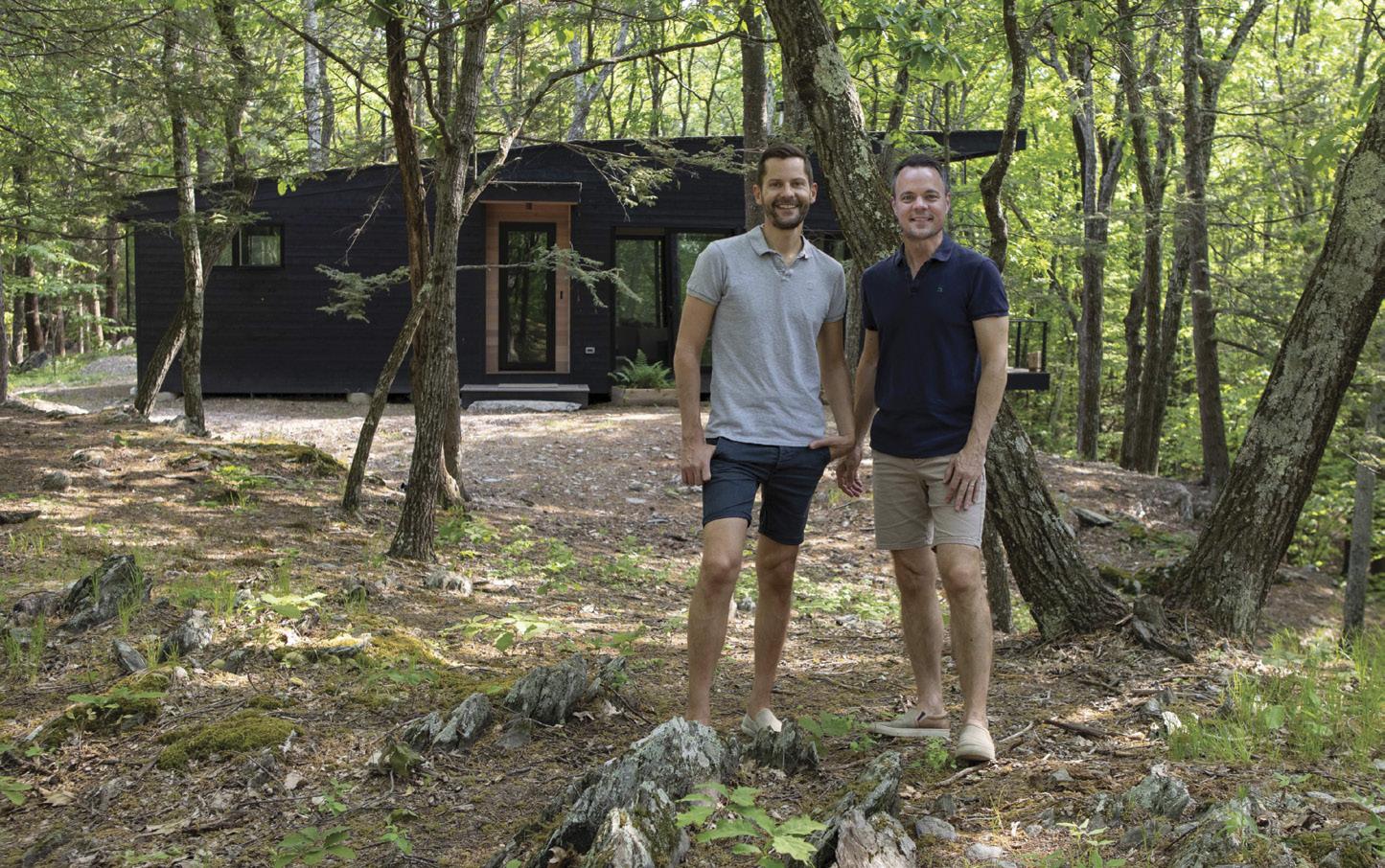
In 2016, after years of restoring heritage brownstones in New York City, an Arcadian longing came over architect Christopher Dierig and his husband and business partner Doug Maxwell. “Wouldn’t it be nice if there was a beautiful, rural area near the city with an agrarian character and lifestyle,” Maxwell recalls that they wondered together. “Then we realized, well of course there was.”
Originally hailing from Kentucky and Texas, the two found a natural fit in northern Dutchess County, where they could reclaim their rural roots amidst like-minded historical preservationists. In 2017 they reimagined their city-based practice S3 Architecture as a design-build firm for the Hudson Valley. Their vision for Upstate Modernist would draw inspiration from heritage forms to create landscape-specific, modernist designs. “We love modernism, but not slap-you-in-the-face modernism,” says Maxwell. “We take a warmer approach, focusing on natural materials and sustainability.”
Before beginning any project, the duo spends considerable time familiarizing themselves with the surrounding property. “We spend a lot of time just walking, quite frankly,” he says. “The land is paramount. We get a sense of the unique
characteristics and what a property is about, both naturally and historically. These factors drive an entire project.”
They bought a legacy farm in Rhinebeck with plans to create their own modernist oasis, first preserving the fields and woods with a conservation easement. Then, as part of their master plan, they began designs for a small on-site studio. “The ‘cabana’ was just meant to be an office for us to work in and host guests,” Maxwell says.
On one of their early farm rambles they’d found a particularly scenic high point. Perched along the edge of a cliff, the spot was thick with stunning mature trees and presented the kind of designbuild challenge the two love to tackle. “It was very, very tight,” says Maxwell of the sylvan setting. “We didn’t want to touch anything and we didn’t want to cut down any trees because it was so beautiful.”
They found a patch of dead hemlocks that would give them just enough room for the cabana’s footprint without altering the thriving treescape. “We took a very light touch in our design approach,” he says. Building on piers, they left the underlying rock intact and cantilevered the structure over the edge of the cliff. Clad in dark shiplap siding, the shoebox-like exterior blends into the rocky landscape and generous
floor-to-ceiling windows throughout the structure erase the boundary between the interior and surrounding woods.
Fast forward: Upstate Modernist grew rapidly and the two didn’t have time for their master build. “So we supersized our studio a bit,” says Maxwell. The former wet bar became a “wildly compact, but fully functional” kitchenette. The upsized bathroom includes a clever in/out walkthrough shower with exterior access. Throughout the primary suite, millwork and furniture made from naturally felled ash trees extends the compact interior into the exterior setting. A wood stove warms the home in cold weather, and plenty of outdoor space—including a deck jutting into the forest and adjacent fire pit and hot tub—spill the living space into the landscape in warmer months.
The two have lived contentedly in their 800-square-foot cabana, bear-hugged by the surrounding woods, for almost five years. The home expresses their design ethic, in miniature. “We design everything to feel correct in place,” says Maxwell. “Not just now but 50, 100 years from now.”
Upstatemodernist.com

Mac Dorris has been an avid cyclist for about 50 years, and when his 21-year-old son, Eric, died of an accidental overdose in 2016, Mac used cycling to help deal with the loss. “When Eric died, the grief was insane,” Mac says. Mac found group rides with friends to be a helpful distraction, but he also found comfort on solo rides where he’d go out on a beautiful road and think about memories of Eric.
At the time of his death, Eric was being treated as an outpatient at McLean Hospital in Belmont, Massachusetts, outside of Boston, for borderline personality disorder, substance use issues, and other mental health conditions. McLean is the psychiatric teaching hospital of Harvard Medical School and is ranked the number one hospital in America for psychiatric care by US News & World Report
According to a 2022 survey conducted by the Kaiser Family Foundation and CNN, one-third of United States adults report that in the past year, they’ve felt anxious “always or often.” The survey also found that one-third of US adults don’t have access to the mental health services that they need, and a whopping 90 percent think our country is experiencing a mental health crisis. For many people, cost is the barrier and 74 percent say insurance doesn’t cover mental health the way it does physical health. On top of insurance falling short, there are other barriers to mental health care. Fifty-five percent say that lack of providers is an issue, 62 percent say that shame and stigma get in the way of care, and 39 percent cite lack of diversity as some of the top reasons that impede mental health care access.
Mac and his wife, Ginny, Eric’s mom, had
The Ride for Mental Health is an annual fundraising ride held each June in New Paltz to raise money for the renonwned pyschiatric research and treatment program at McLean Hospital in Belmont, Massachusetts.
already started a fund at McLean, but about a year after Eric’s death, Mac realized he wanted to do something additional to honor his middle son. “I was basically reaching retirement from my legal career and trying to figure out what to do with the rest of my life,” Mac says, so he started researching charity bike rides that raise funds for mental health. “I found almost zero, which was really striking to me.”
Mac and his family lived full-time in Brooklyn when he worked in the city, but they’ve owned a home in New Paltz since 1990, and Ulster County seemed like a great spot to base the Ride for Mental Health, a non-profit that raises money for the education, research, and treatment of mental illness at McLean Hospital. “New Paltz is a great area to ride,” Mac says. The community is progressive, and I knew they’d support the event

and have no problem attacking the stigma of mental illness head-on.”
Despite the community’s support, Mac says organizing a charity bike ride was daunting, but his background as a finance lawyer turned out to be helpful. “When you do big financing, you have 200 pieces of paper that you have to put all together, figure out how they all work, and get everybody to agree on everything,” Mac says. “Organizing a charity bike ride is kind of the same thing.”
Mac learned how to organize the ride by talking to other charity bike ride organizers, and, like a good lawyer, he did his due diligence. One of the most important things Mac learned—when his brother was already out on the course putting up one sign for every turn—is that you need three signs for every turn. “You’ve gotta have one before the turn, one at the turn and then one after the turn to let people know they did the right thing,” Mac says. On long straightaways, they put up signs every mile, so people don’t have to wonder if they got lost.
The Ride for Mental Health doesn’t spray paint the roads, permanently alter the route, or leave any trace, and, as a result, the main floor of Mac
and Ginny’s barn is filled with hundreds of ride signs. “They’re organized by left turns, right turns, straight signs, the half left, the half rights, the rest stop signs, and the rest-up-ahead signs,” Mac says. It takes an entire day and several teams of volunteers to put up all the signs, partly because the ride has various options for different skill and motivation levels.
The Ride for Mental Health includes a 25-mile ride, two 50-mile rides (a north loop and a south loop), and a 100-mile ride, which is both 50-mile rides put together. Riders who want to complete the 100-mile ride in a single day must do so on Saturday, but Mac says some riders complete the century ride by doing 50 miles on Saturday and 50 miles on Sunday. In addition, there’s a 14-mile rail trail option for younger riders, families, and those who don’t want to deal with cars.
The Ride grew from 100 riders in 2017, its inaugural year, to over 400 in 2023. This year’s event takes place on June 22-23. Last year, the Ride had over 50 sponsors and 1,600 donors
to help pay for event expenses not covered by registration fees. Mac knows the Ride is still on the small side, but he hopes it will continue to grow and he treats it like a world-class event, which requires at least 150 volunteers.
Eric’s mother, Ginny, is instrumental in organizing volunteers, and she recruits a big group of friends and family to help throughout the weekend. Eric’s older brother, Greg, usually rides on Saturdays and volunteers on Sundays. Eric’s younger brother, Peter, volunteers all weekend doing whatever is needed, including loading refreshments into volunteers’ cars so they can be delivered to aid stations and the finish line.
“The event is about creating a community that is shining a spotlight on mental health and helping to erase the stigma associated with mental illness,” Mac says, noting that the pandemic and other societal factors, such as the increase in social media, have spurred a rise in anxiety and other mental health conditions, and young people are the most vulnerable.







One of Mac’s favorite things about the Ride—beyond honoring Eric and raising funds for McLean Hospital—is the way the Ride brings people together. People come from all over to recognize their friends and family who have struggled with mental illness, and the Ride gives people the opportunity to share their stories with others. Mac says a group comes every year from Buffalo to ride with the sister of a man who suffered from depression and committed suicide in his fifties. Mac’s cyclist friends from Brooklyn come up. “One friend lost his sister to suicide when she was young,” Mac says, “And another lost his brother. They had no idea that he was suffering from depression.” Whether riding or volunteering, Mac says people tell stories all weekend, and the sharing and connecting is healing.
Unlike many charity events, the Ride takes place over two days, and on Saturday night, there’s a hosted dinner for all riders and volunteers. The dinner includes a cocktail hour with live music followed by a buffet dinner, which is an essential component of the ride, as it provides all participants— cyclists and volunteers—with time to relax, hang out, and tell more stories.




The Ride for Mental Health started in 2017 and has raised over $1.2 million since inception. The bulk of the funds has been donated to McLean Hospital, but the Ride has also donated $15,000 to the New Paltz Youth Program and $15,000 to the Maya Gold Foundation, which was created by Elise Gold and Mathew Swerdloff, parents of Maya Gold, a New Paltz High School student who took her own life in October of 2015 at age 15.
The Maya Gold Foundation’s mission is “to empower youth to access their inner wisdom and realize their dreams.”
The Ride for Mental Health takes place in June, but because May is Mental Health Awareness Month, it’s a great time to sign up and get some training rides in, especially if you plan to do one of the longer rides. It’s also a great time to commit to volunteer. Sign up to ride or volunteer at Rideformentalhealth.org
Mental Health Awareness Month has been observed in the United States since 1949, often with film screenings and other media events, and on Saturday, May 4, there will be a screening of Charm Circle at the Beacon Theatre at 445 Main Street in Beacon. Charm Circle is a documentary by Nira Burstein that offers an intimate, immersive account of the filmmaker’s family’s emotional, financial, and social struggles as they navigate a family crisis while also moving from their longtime home. This screening is produced by Shane Killoran, CEO of Hit House Creative, and Dr. Hannah Brooks, founder of Beacon LitFest.
Following the film, there will be a moderated discussion with Steve Miccio, CEO of People USA and Andrew O’Grady, CEO of Mental Health America of Dutchess County. “We wanted to support these filmmakers in trying to destigmatize mental illness, to deepen our community’s understanding and open up real dialogue around the issues,” Brooks says. “We also want to shed light on the organizations in our area doing the heavy lifting in providing support to affected individuals.”


Take Back Your Health with Acupuncture, Detox, Nutrition, Herbal Medicine, & Biofeedback/ Neurofeedback Frequency Healing
Specializing in Lyme, EBV, chronic fatigue, pain/injury, auto immune, digestive disorders, migraines, neurological disorders, & skin issues
Dr. Erika S.Gabriello DACM L. A c www.holisticnaturalmedicine.com 347.988.0178 New Paltz 169 Main St.




On March 4, tensions flared at a Beacon City Council meeting as 68 speakers debated over adopting a resolution for an immediate ceasefire in Gaza. The room was split. While many there supported the resolution, a sizable group opposed it.
Chaos erupted when audience members objected to a man who compared resolution supporters to “people terrorizing their own citizens.” After the interruption, Mayor Lee Kyriacou reset the man’s three-minute time limit, prompting Neesee Lee—a Wallkill resident of Palestinian descent—to refuse her own limit, accusing Kyriacou of allowing racist remarks. After her time expired, Lee began to shout, and city administrator Chris White unplugged her microphone. Ultimately, after over three hours of public comments, the measure passed 5-0, with Kyriacou and Ward Two councilmember Jeff Domanski abstaining.
“The meeting was very emotional,” says White. “Some of our speakers simply wouldn’t acknowledge that there were time limits or rules. The council, at first, was not going to pass a resolution because they felt it’s not a local issue. After
public comments, the majority passed it, mostly so we could get back to city business.”
According to Katie Hellmuth, founder of A Little Beacon Blog, who came out in support of the resolution, the meeting “brought out a lot of people who are normally quiet and afraid to speak, and they spoke. They brought local wounds to the podium. That’s why the ceasefire resolution became localized; everyone opened up about what it means for their lives here. They were sharing their experiences of racism in Beacon, which people don’t like to acknowledge.”
Hellmuth has lost roughly 2,500 followers on her blog’s Instagram since she began posting political content about Palestine. “When I started covering that, it was mostly reposting news, but I’ve also included my personal feelings. A Little Beacon Blog was always meant to be its own thing— it’s not just for Katie Hellmuth. But for this issue, I did step out. Someone said to me, ‘You broke through the fourth wall,’ because it was so hard to report on. I’m one of the only publications in the Hudson Valley who is publishing about it. It’d be nice if others did too.”
Chris and Elizabeth Tillman, who were up for the day from Bergen, New Jersey.
Opposite, top: The Hudson Valley Food Hall is home to a half dozen food stalls like the recently opened British eatery Moreish, run by Mike Johnson and Shey Aponte.
Bottom: The Howland Cultural Center, formerly the Howland Library, was designed by noted architect Richard Morris Hunt in the 1870s. It now hosts performances and exhibits throughout the year.




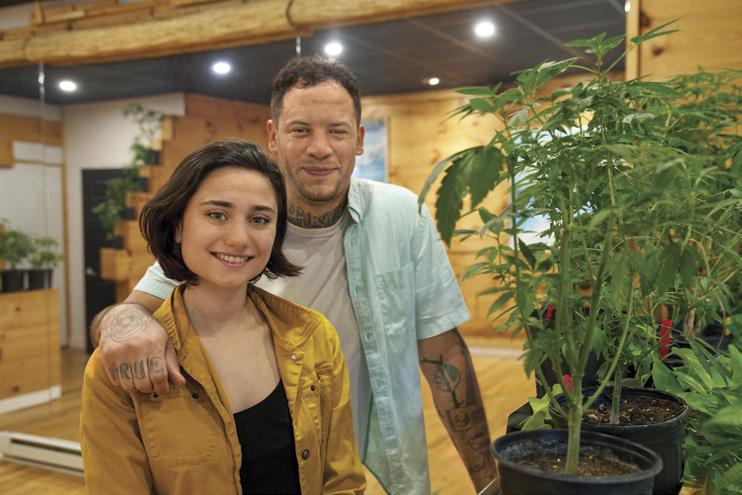
For journalist, editor, and podcaster Zach Rodgers, who produces the “Beaconites!” podcast, strain over the ceasefire represents a larger trend in Beacon. “Every so often there’s a progressive movement that will take hold on a specific issue,” says Rodgers. “The anger and the conflict does take a toll. I think we’ve seen it happen with some other issues, including Black Lives Matter—there was a reckoning at City Council during that. There’s this kind of interesting tension here between progressive elements and pragmatic considerations. It’s led to some big blowups.”
Rodgers has lived in Beacon since 2007. Through his podcast, he’s interviewed over 100 local figures, and he’s seen the city’s changes. “Beacon used to have poor-city problems, and now it has rich-city problems,” says Rodgers. “To me, one way to think about it is this: Since I moved here, once every two years there’s been an article about this cool town in the Hudson Valley that’s gritty, culturally interesting, creative, and affordable. This February, the New York Times put out an article about towns you can’t afford to live in. It’s kind of the opposite of what used to run about the city. Beacon retains a lot of its character, but it’s starting to lose diversity, including economic diversity and the cultural diversity that used to define this place.”
Last year, Jeff Simms, the Beacon editor for the Highlands Current, analyzed US census data to consider how changes in the city over the past two decades have impacted those with lower incomes. He found that approximately 30 percent of households in the city earned less than $50,000, whereas in 2000, around 75 percent of households earned less than $50,000 (adjusted for inflation).
As economic diversity shrinks, development and affordability have become pressing concerns for many. One of the larger housing projects currently underway in Beacon is the Edgewater apartment complex, which overlooks Pete and Toshi Seeger Riverfront Park. By the end of 2025, Edgewater plans to have constructed a total of 246 rental apartment units at their seven-building apartment complex. And according to the City Administrator Chris White, the city is applying to the state to become a “ProHousing Community,” a designation required by New York State to be eligible for certain State grant funding without additional revenue or legislation.
Top: Nilufer Goodson, owner of Nilufer’s Home Kitchen with her husband, Addison Goodson.
Middle: Jill Facko is the owner of Sybil, a home goods store.
Bottom: Aaron Sanders and Skyla Schreter at LotusWorks, which was awarded the city's first cannabis license.
LotusWorks' microbusiness permit will allow the couple to grow cannabis, process, and sell cannabis flower and other prodcuts.
Opposite, top: Ali T. Muhammad, chair of Spirit of Beacon Day in South Avenue Park.
Bottom: Katie Hellmuth, founder of A Little Beacon Blog, at Long Dock Park. Hellmuth has endured criticism and harassment for expressing pro-Palestinian views on her site.



Still, the issue is on everyone’s mind. “Affordability is a huge challenge, and no one seems to have the answer,” says George Mansfield, who recently concluded 14 years on the City Council. “Beacon doesn’t have deep enough pockets to incentivize developers. There are things we can do, but they run the risk of having no development at all because the numbers don’t work for developers, or people get scared off by too many requirements.” According to Mansfield, it’s possible that the city can control zoning regulations to encourage affordable housing developments or require developers to allocate 10 percent of their units for affordable housing.
In February, the state’s Cannabis Control Board approved 109 marijuana licenses, making the LotusWorks art gallery and wellness studio the first Beacon business to receive a cannabis license. (In mid-April Beacon restaurateur Kamel Jamal, who owns Beacon Bread Company and Ziatun, was also awarded a dispensary license.) LotusWorks will start planting its own crop in spring 2025, but until then, it will get buds, rosins, distillates, joints, and edibles from other processors. “Part of the reason we were able to receive our license approval is because we are a minority and womanowned business and social equity applicants,” notes coowner Aaron Sanders. “We worked very hard to have this opportunity, and the State of New York and the City of Beacon are helping to rectify the years of unjust treatment and the uneven playing field that I have faced throughout my life, not only as a legacy cultivator but as a person of color.”
LotusWorks is currently closed for renovations as it prepares to reopen as a dispensary. Prior to this, the business only offered services on Saturdays and Sundays, reflecting the importance of weekend tourism for many Beacon businesses. “I think Beacon’s now a daytrip town,” says Bob Nevelus, a retired police officer turned Culinary Institute of America grad who has owned the Beacon Falls Cafe since 2008. “A lot of locals don’t really support local businesses; they go to Route 9, go to chains. Thank God for all the new people. Some of the old-timers here call them ‘citiots,’ but I don’t know. Those ‘citiots’ keep us in business. I call them good customers.”
However, even with an influx of tourists, running a business in Beacon presents its own set of hurdles. The limited availability and high cost of commercial real estate can pose a challenge for entrepreneurs. That’s why spots like the Hudson Valley Food Hall, an indoor market that leases out individual stalls to multiple food vendors under one roof. are so valuable “Myself included, none of us could afford the overhead of this space on our own to run a full restaurant,” says owner Marko Guzijan, who grew up in Beacon. “But you can ask someone to come into the food hall, and for a fairly low rent, they can open up.” Some of the eateries that started out in the food hall, like Momo Valley and the Elixxr Cafe, have gone on to start their own brick-and-mortar locations.
The most recent additions to the hall include Old Dhaka Coffee, Moreish, and Five Pennies Creamery. Guzijan makes sure that vendors don’t compete by offering the same foods, and he argues that diversity is the key to the












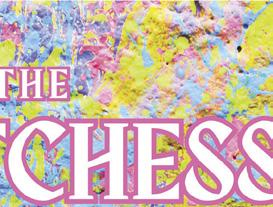





Meticulously sourced, genuine gemstones of exceptionally high quality, free of synthetics, dyes, and coatings. Each piece is designed to be a unique and enduring expression of color and texture to be enjoyed for many years to come.
& SUNDAY, 1-8





















hall’s success. “We’ve got six different languages spoken by chefs in the food hall, and we come from nine or ten different countries,” says Guzijan. “If you line up these vendors, we’re like the United Nations of food halls.”
The city is about to begin $40 million of capital improvements through state and federal funding, such as road, sidewalk, water, and wastewater projects, as well as the rehabilitation of Fishkill and Teller avenues. There’s also the ongoing construction of a $14.7 million, centralized fire station. The all-electric, energyefficient station, heated and cooled by a geothermal system, is on schedule for completion by late summer.
Dia Beacon, often cited as a major catalyst for the city’s rejuvenation since its opening in 2003, has commissioned landscape architect Sara Zewde of Studio Zewde to transform the museum’s eight back acres into a public outdoor space. The project aims to create an environment featuring meadows, native plants, walking paths, and areas for picnicking. The design also addresses climate change challenges, such as stormwater management, with features like underground tanks to collect and filter water. The project is expected to open to the public in 2025.
Since 1977, the annual Spirit of Beacon Day has been organized by a volunteer committee, taking place every last Sunday of September as a city-wide celebration featuring festivities and a parade. Ali T. Muhammad, a Beacon native serving as this year’s chair, aims to enhance inclusivity and community engagement for this year’s event. “People don’t understand how diverse this community is,” says Muhammad. “It’s whiter [than it was], but it’s still diverse.”
His goals include incorporating more cultural foods, introducing hip-hop and R&B music, hosting a DJ cypher session—a freestyle showcase where multiple DJs take turns mixing and scratching tracks—creating a picture board for sharing memories, and honoring deceased community members. “We’re hoping to attract more people from the areas of Beacon who don’t occupy Main Street because they don’t feel comfortable or because there are so many tourists,” says Muhammad. “Can you imagine growing up here your entire life and not supporting this because it doesn’t feel like home?”
Reflecting on Beacon’s past and present, Muhammad notes that, “Gentrification does help clean up and improve communities—to a certain extent. The problem is that it often, if not always, leads to the displacement of the people who have lived there for years. Especially with inflation, recessions, and pandemics, people can be pushed out immediately. What happened in Beacon was both beautiful and a mistake.”





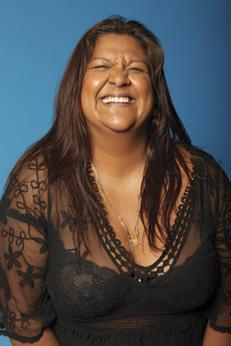



We were tucked up in the mezzanine at the Hudson Valley Food Hall in Beacon for our community pop-up shoot on April 12. Beaconites came out in force! Thanks to Marko Guzijan for hosting us at Hudson Valley Food Hall (and the delightful cocktails from the Roosevelt Bar). Thanks to Mike and Shey from Moreish for the delicious bangers and mash and steak and Guinness pie. And thanks to ex-mayor turned bartender Randy Casale for his help. community pages









Join us for the May issue launch party on Thursday May 2 at The Vinyl Room, 396 Main Street in Beacon, from 5:30 to 7:30pm.










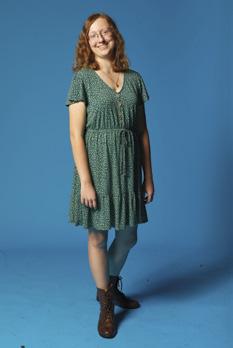
Top row: Amy Bandolik, Beacon Farmers’ Market manager and Thomas Bregman, Dia:Beacon gallery attendant; Erin Ashoka and Veekas Ashoka, cofounders of Beacon Climate Action Now with Oak Ashoka; Vic Alam, DJ and owner of Old Dhaka Coffee House.
Middle row: Adam McKible, English professor, John Jay College; Amy Soucy, embodiment coach; BAU gallery members: Karen Allen, Kelly M. O’Brien, Bob Barry, and Robin Adler; Armando Salinas, chef/owner of El Nica; Scott Tillitt, Beahive founder.
Bottom row: Carolyn Brazil, director of recreation at the Lutheran Care Center and Gene Brazil, Metro-North Railroad; Julie Winterbottom, writer and musician; Emily Murnane, local historian, writer, and storyteller; Cristhia M. Acevado, Dulce Ceulo MX restaurant; Daniel Blackburn, pastor at Star of Bethlehem Baptist Church.
Inset: The Beacon Climate Action Now crew: Brian Mandel, Bill Irwin, Larry Reader, Willman Duffy, Sam Quon, Jessie Van Amburg, Erin Ashoka and Oak Ashoka, Jesse Ragan, Ally Valeda-Maiden, Harper Horwitz, Veekas Ashoka, Susan Austin; Lena Bilik.
Opposite, top row: Bill Irwin, photographer, social worker, climate activist; Melissa McGuinness, Hakan Chocolatier; Bradley Silver, tattoo artist and owner at Distortion Society; Candace Figueroa, warehouse worker; Danny Freeman, social media influencer and author of Danny Loves Pasta
Middle row: Diane Lapis, Beacon Historical Society Trustee; John D. Wiggins, II, owner Miz Hattie’s BBQ; Jessie Van Amburg, writer and editor; Frank Mesa, owner ChangoLife Arts gallery; Lauren Coupe, Howland Public Library office manager.
Bottom row: Sweta Driver, psychologist; Rick Zeno, DJ; Quincy Savage, barback at The Roosevelt; Paola Herrera, owner, FCM Cleaning Company; Pam Wetherbee, City of Beacon Councilmember.

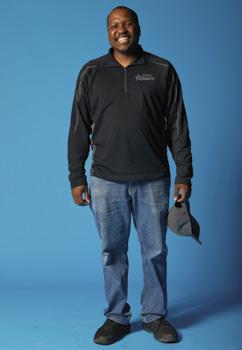







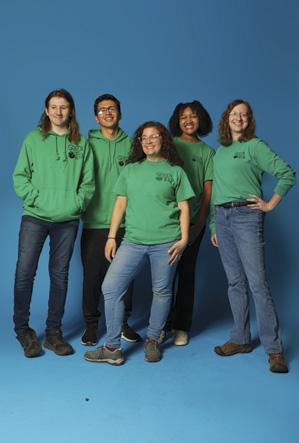


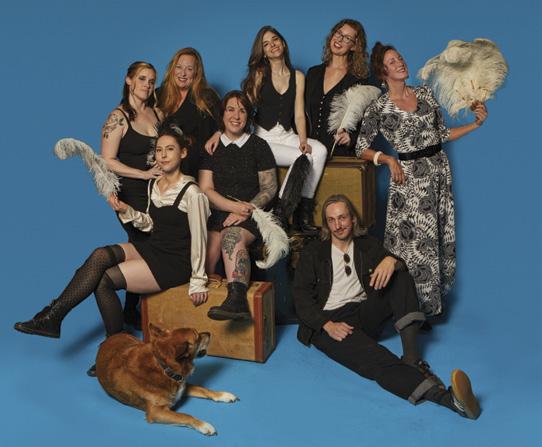






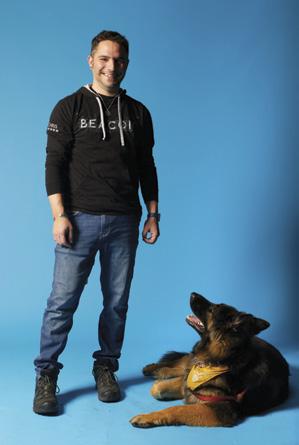











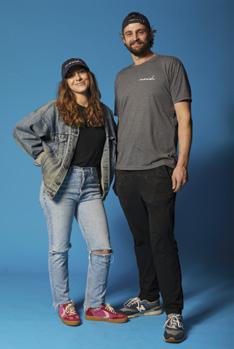






Second
Third

1552 Route 9, Wappingers Falls (845) 227-4021 Locksthatrock.com
Locks That Rock Hair Design has been a locally owned hair salon in Wappingers Falls for over 30 years. They offer hair services for women, men, children, and seniors. Locks that Rock is a positive, professional, and upbeat salon with a warm and inviting environment, where clients are treated with the respect they deserve. They work with all hair and skin types to create the look best suited to your individual style and taste. In need of a new haircut, new hair color or have a special occasion coming up? Make Locks That Rock the go-to hair salon.

1065 Main Street, Fishkill (845) 896-2840 Fireflyfishkill.com
Nestled in the charming village of Fishkill find an empowering and diverse yoga community. The studio boasts a bright and airy room for up to 40 yogis at one time. Each day find up to 7 classes in varying styles and schools of yoga in a heated setting. Classes are set to approximately 90-98 degrees, a comfortable and yet challenging temperature to awaken and empower each student into breath, mind, and body connection. After 10 years in business, their community comes from all over the tri-state area to experience these practices. The teachers support each student along their journey and teach to all levels, all the time. From athletes to those who are new to yoga to avid fitness go-ers, there's a place for them all here.

Hudson Valley Shakespeare Festival
2015 Route 9, Garrison (845) 265-9575 Hvshakespeare.org
Founded in 1987, the Hudson Valley Shakespeare Festival (HVSF) is a critically acclaimed theater company known for its inventive productions staged under an open-air tent overlooking the Hudson River. In its new permanent home in Garrison, audiences can pair a show with a picnic on the grounds, enjoy panoramic river views, and learn about HVSF’s plans for the nation’s first purpose-built LEED Platinum theater, construction of which will soon be underway.
The 37th season, which runs June through September, brings HVSF’s trademark playfulness and imagination to classic stories in thrilling new adaptations by three living American playwrights. “A classical theater company like ours is always building bridges between the past and the present, a conversation across centuries, or sometimes millennia, that happens in the very present moment of live performance,” says HVSF Artistic Director Davis McCallum.
Adapted from Shakespeare’s “Henry VI” and “Richard III,” Whitney White’s “By The Queen” is a sharp, humorous, and of-the-moment look at the Bard’s story of the War of the Roses as told through the lens of Queen Margaret’s reflections on her remarkable life.
Agatha Christie fans won’t want to miss the world premiere of Heidi Armbruster’s highly theatrical adaptation of the 1926 masterpiece from the Poirot series, The Murder of Roger Ackroyd—a re-invention of the pleasures of the theatrical whodunnit in HVSF’s signature playful and freewheeling style.
The world premiere of Luis Quintero’s hip-hop version of Euripides’ ancient tragedy “Medea: Re-Versed” offers up an ice-cold, high-octane adaptation that is as terrifying and shocking today as it was 2,000 years ago.
For HVSF’s season schedule, tickets, and more information visit Hvshakespeare.org.

If you’ve met someone for coffee in Pittsfield, you’ve been to Dottie’s; that’s just the way it is.
Formally named Dottie’s Coffee Lounge, the coffee shop and community meeting place on North Street, named for owner Jessica Rufo’s grandmother Dorothy, has been open since 2007, and is now a longstanding anchor on Pittsfield’s main drag. In addition to serving baked goods, coffees fancy and simple, breakfast fare, and light lunch, the coffee shop is a known community meeting place, and it’s not uncommon to see the side dining room packed with Pittsfield’s business leaders taking a break, working from a laptop, or scheming up the next cool thing.
The shop’s walls are filled with local art (for sale). Colloquially called “Pittsfield’s living room,” it’s the space folks use for everything from WordXWord story slams to family fun nights to special-themed menu events. Rufo says around 70 percent of the customers at Dottie’s are regulars. “We’re looking out, we’re taking care of one another. It’s definitely a two-way street,” she says.
A Craving for Community
Rufo was inspired to create Dottie’s after going to college in Boston, and then living in New York City, where she
worked at a coffee shop and got to know her community from behind the counter. “You talk to them, you get to know them, they become a major part of your life,” she said. “That became very comforting to me, in my 20s in an enormous city. I started to really see the value in community and how coffee shops bring people together. I started to crave having my own coffee shop and building my own community.”
Around that same time, she decided to move back to the Berkshires, where she grew up hanging out in downtown Great Barrington and Lenox. “It always confused me that Pittsfield was overlooked and underutilized,” she said. “When I thought of places that could use a better sense of community, I instantly thought of Pittsfield.”
As Dottie’s has served tens of thousands of customers (or more) the city has grown and changed, too. In the early days of the business, “it felt like we could make Pittsfield anything we wanted it to be. It seemed to me that if I just opened up something cool, then someone else would open up something cool, then someone else would open up something cool,” says Rufo. “There are ebbs and flows. Right now, we’re on an upswing, with lots of new businesses opening downtown.”
Opposite, top: The restaurant is in the former space of the former Mission tapas bar.
Middle: Auron Stark mixing a Domingo Mimosa.
Bottom: Dottie’s is colloquially known as “Pittsfield’s living room.”
One of those new businesses is actually Rufo’s new restaurant, Dorothy’s Estaminet, which opened in February in the former Mission tapas bar space next door. (An estaminet is a small French bistro.) It’s connected to Dottie’s both physically and spiritually. Dottie’s serves a daytime crowd and Dorothy’s is open from 2 to 9pm. The dining room that connects the spaces serves both restaurants, allowing customers to take advantage of more ample seating. It’s been called “the best restaurant in Pittsfield” for its laid-back-French-cafe concept and for its simple menu, which centers around a Mediterranean-style shared plate called The Experience, which guests can pair with their choice of protein (vegetarian options abound).
“Dorothy’s menu is meant to bring people together in the same way the coffee shop does during the day,” Rufo says. “It’s like this awesome dinner party. You immediately have food to dive into with your people.”
At Dorothy’s, Rufo has also added music, with occasional residencies, including a flagship residency with renowned band Misty Blues, and lots of independent musicians providing evening entertainment.
She says she’s thankful to have such a robust team—not just the kitchen and waitstaff, but also volunteers like artist Richard Britell, who curates monthly art shows at Dottie’s. “When I say ‘we,’ I am first and foremost talking about the people who use Dottie’s as a place to gather,” she says.
Rufo was all-in on downtown Pittsfield before, but post-Covid (when the coffee shop mostly stayed open and also provided some wholesale grocery options for community members in times of need) she’s thinking deeply about how to continue and build upon her work. “Our community and culture are really suffering from isolation, distraction, numbness, loneliness. I really feel coming together over food and breaking bread, as they say, is the antidote to that,” she says “We just want everyone to come have this experience with us. It’s good nourishing food, and a really nourishing experience.”
Rufo particularly loves when someone tells her they know a Dottie or a Dorothy, since she cherished her grandmother and the name means so much to her. “It’s nice to know that name means so much to someone else,” she said. “She adored me and I adored her. I named my business after her because of how she made me feel.”


Get all the latest news and events from the Berkshires and Northwest Connecticut delivered to your inbox twice a week. Scan to sign up. Let Ruralintelligence.com be your guide.

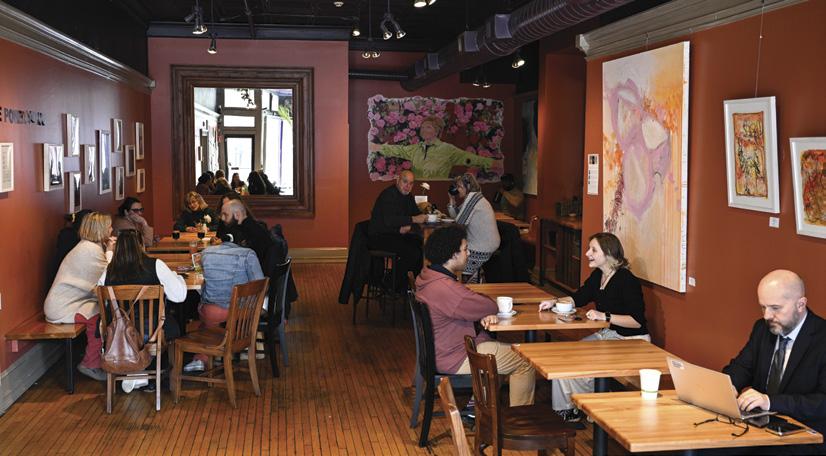





































“Every Hook in the Book”
May 3-June 30 at Lapin Contemporary Gallery in North Adams
Both a painter and musician, Karl Mullen titles his exhibit “Every Hook in the Book,” words from the lyrics of one his original songs and a reflection of his approach to painting and life. The works on view present large-scale and abstract canvases and paper, richly layered with a mixture of vinyl emulsion paint, markers, oil pastels, pencils, raw pigment, clay earth, tea, and red wine.
Haneef Nelson Quartet
May 4 at Old Town Hall in West Stockbridge
The West Stockbridge Jazz Concert Series kicks off the season with the Haneef Nelson Quartet. Nelson has played with a long list of leading jazz musicians, including Yoron Israel, Avery Sharpe, Bill Saxton, Paul Brown, Feya Faku, Valery Ponomarev, Musiq Soulchild, Doobie Powell, and several others. His original music and big band arrangements have been featured around the world and on the records of the New London Big Band, as well as Emmett Goods’ album, Another Level. 7pm.
“a world between worlds…”
May 4-June 9 at Carol Corey Fine Art in Kent Nathaniel Aric Galka’s paintings are exquisitely executed depictions of fantastic worlds filled with stylized flora and fauna, and filled with historical art and cultural references. His works are constructed using Old Masters techniques: marble plaster gesso, oil paints, and India ink, then varnished to feel as if they are historical fragments. Meet the artist at the opening reception May 4, 5-7pm.
Gilbert and Sullivan: Favorite Opera Excerpts
May 4 and 5 in Lakeville and Great Barrington
If you’re a Gilbert and Sullivan fan (and we know you’re out there), you’ll want to be at Crescendo’s production, which includes the Crescendo chorus, soloists, and an instrument ensemble. The one-act comic opera “Trial by Jury” will be presented in a semi-staged, costumed version, and “The Trials of Love in the Spring” features some of the most favorite solo and ensemble numbers from G&S’s operas “Patience,” The Pirates of Penzance,” “H.M.S. Pinafore,” and others. $40-$75. May 4 and 5 at Trinity Church, Lakeville, 6pm. May 5 at Saint James Place, Great Barrington, 4pm.
Central Berkshire Record Show
May 5 at The Stationery Factory in Dalton
Vinyl aficionados, listen up. The Central Berkshire Record Show returns for the second year with thousands of records and CDs from top vendors in the New England area. DJs will be plying their turntables throughout the event; food and drink, including craft beverages, will be available on site via The Shire Breu-Hous. VIP Admission (8:30am), $20. General admission (10am-4pm), $4.
Berkshire Botanical Garden Plants-And-Answers Plant Sale
May 10-11 at Berkshire Botanical Garden in Stockbridge
This year’s Plant Sale features hundreds of perennials, annuals, and vegetables with a focus on nature-based landscaping. As always, the sale will supply the best robust plants for landscape and container gardens, along with a wide selection of organic vegetables and herb plants. The best part: it’s an opportunity to interact with the Garden’s popular “Ask Me” staff and volunteers for expert advice. All proceeds from the plant sale support the Garden’s horticulture and education programs. $18. Friday, 11am-5pm, Saturday 9am-4pm.
Heirloom by Design
May 11 at Greylock Works in North Adams
Heirloom by Design is a spring market that celebrates the handcrafted magic of the Berkshires and beyond. Spread throughout Greylock Works, a light-filled former mill, the market will also include food from farmers, fermenters, and the region’s best artisan makers. Free. 10am-4pm.
May 18-19 at Lime Rock Park in Lakeville
It’s the most anticipated garden event of the year, and a major fundraiser for Project SAGE, a nonprofit that provides emergency shelter and support services to people facing domestic violence. Trade Secrets Rare Plant and Garden Antiques Sale features the finest plant and garden antiques vendors from the northeast region and beyond. It returns for its 23rd season with garden tours at multiple locations on May 18, and, of course, the extremely high-end rare plants and garden antiques sale on May 19. Don’t forget to bring your little red wagon. $50-$150.
—Lisa Green









Camp Saint Helene, from Catskill, captivate and conjure a perfect picture of Catskill Mountain mystical wistfulness and longing on their sophomore release, Of Earth and Its Timely Delights. Elizabeth Celeste Ibarra’s voice, paired with rustic-yet-sharp folk influences, evokes “Who Knows Where the Time Goes?”-era Fairport Convention. Or maybe the great lost sleeper mid-’70s psych record Inside the Shadow by Anonymous, if they were having a strong coffee on a cold morning (see also the warm distance of Folkesange by Myrkur). “Racing” is the calming blanket you’ve been waiting for. Camp Saint Helene’s early stuff was recorded on eight-track, and while I suspect the production has bumped up here, there is nonetheless a very intimate and fittingly earthy aesthetic at play. Lovers and dreamers alike will definitely want to catch the outfit at one of their upcoming local appearances.
Morgan Y. Evans

John Esposito Sextet Laura (Sunjump Records)
John Esposito Trio Blues for Outlaw Hearts (Sunjump Records)
Columbia County composer/pianist John Esposito has worked with a ridiculous list of major jazz talents. He has two new offerings out, both anchored by the dynamic rhythm section of bassist Ira Coleman and drummer Peter O’Brien. Blues for Outlaw Hearts, a trio disc, showcases Esposito’s own fluid playing. Laura, recorded back to back, expands to a sextet, with the addition of Phil Allen, Chris Pasin, and Eric Person on horns and woodwinds. The latter, not surprisingly, offers a fuller sound, but still keeps the focus on Esposito as leader. The width of his voicings leaves plenty of room for both air and for his fellow players. When he does dig in, it’s with a big, open sound, redolent of hard bop pioneer Horace Silver (though with a leaner left hand) or an up-tempo, spirited version of contemporary master Kenny Barron. The epic “Sunlight” unleashes an Ahmad Jamal-like exuberance, beams of notes arcing through a late afternoon. The ersatz title track, “Outlaw Hearts,” slows things down, decorously, with O’Brien’s cymbals offering a shining counterpoint.
Laura, as noted, is a richer ride, with the frontline crackling from the first late-’50s beat of “Clarity.” “Blues for Bugalu” lopingly lives up to its name, with a fine valve trombone solo from Allen leading into a nice takeoff by Pasin. “La Leque,” led by Person’s flute, again emphasizes a welcome space in Esposito’s compositional sense. The closing “A Sailor’s Farewell” is the clincher, with challenging, fraught harmonies that have been begging to be brought forward.
—Michael Eck
(Miracle Fish Records)
This bewitching platter from the Newburgh duo Fortunteller is one good thing to come out of the pandemic. The duo of Laney CS (producer, vocals, keys, rhythm guitar, bass) and David Saracino (drums, lead guitar) submersed themselves in their basement home studio in late 2022 and emerged with this multi-genre gem. Embracing raw garage rock, surf, Filipino folk music, and more, this album is a vibrant debut. The single “Magindara” is a spacious, spooky tune that gradually swells in intensity. According to the band, it was inspired by “an underwater Filipino folklore tale about the evil sirens that haunt the seas in Bicol, Philippines.” Elsewhere, a crushing cover of the White Stripes “Hypnotize” pulverizes the original. Laney is also founder of the fledgling Miracle Fish record label and magazine (the latter centers on women artists). Hopefully this is just the opening salvo from this adventurous project.
—Jeremy SchwartzEach month here we visit with a member of the community to find out what music they’ve been digging.
Paula: My current faves are the Hitchcocks from Brazil. We’ve been playing them for several years. Their song ‘“Spaceman Go Trip” on their seven-inch, four-song EP on Missing Fink Records features some really phenomenal guitar work! How’s about some new John Cale? “How We See the Light” is the first single from his latest album, POPtical Illusion It’s brand new! Any John Cale fan is going to love it! Linda From Work is a new band from Seattle. Their “Wasting All My Time” is pretty much what all of us do what we go to work at our daily grind that we all hate! Their recent vinyl LP is The Night is Short. No time is wasted giving Linda From Work a few plays! “Everybody Loves My Mom” by the Exbats
is another that I like. Gee, Dick, it’s a catchy tune, I’ll give it an 89 and you can dance to it! Everybody should love the Exbats! They’re based in Bisbee, Arizona, and their album is E is for Exbats.
Amanda: We recently saw Messer Chups perform. They’ve been included on several LP releases on Missing Fink Records that we’ve been playing recently, like the Music to Battle Apes By compilation, which includes their tune “Surf Del’Amore.” Also on the Apes compilation is Dave Del Monte, a local favorite on played on Poughkeepsie radio going back to 2004. Dave’s “See No Evil” is on the 12-inch maxi single included with the LP.
“The Paula and Amanda Show” airs on Fridays at 7pm on 91.3 WVKR-FM and Wvkr. org and on Sundays at 2pm and 11pm EST at Transradiouk.com.




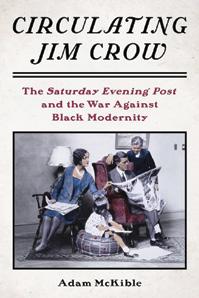
The Eighth Moon: A Memoir of Belonging and Rebellion
Jennifer Kabat
MILKWEED EDITIONS, 2024, $18
In 1845, a ragtag assemblage of tenant farmers in the western Catskills took on their abusive absentee landlords, dressing up in calico drag and masks and waging what would become known as the Anti-Rent War. In 2005, a young writer wrestling with chronic fatigue syndrome moved from London to the western Catskills sight unseen, knowing nothing of that history, as most don’t. The ancient spell of Pakatakan Mountain, the struggles of ordinary folk, and the contrasts of modern-day Margaretville frame this lyrical and transcendent memoir.
Diamond City
Marianna Boncek
ATMOSPHERE PRESS, 2023, $17.99
In 1955, a tiny town is riven by the murder of a young woman belonging to an outsider religious sect. The town’s sole law officer wants justice. Complicating matters, her sister is the mother of his secret child; complicating matters further, the townspeople scapegoat her entire community. Much is shoved under rocks only to be unearthed four decades later, when that child shows up. Boncek, a native of the Sullivan County outback now living in Woodstock, transcends thriller territory and maps the mysteries of the heart.
Loving Scott: A Memoir
Pat Horner
EPIGRAPH, 2023, $20
Woodstock-based artist Horner, 18 when her son Scott was born in 1963, mustered the courage and good sense to nurture and support his gift for style, performance, and all things sparkling through a Midwestern childhood. He would grow up to become an iconic drag performer who dazzled New York and Europe as Miss Demeanor/Misty, and a makeup artist whose work graced high-end fashion magazines. Horner’s collage of biography and memoir sketches the 50 years of Scott’s complicated life and beautifully illuminates decades of social change through a deeply personal lens.
Chopping Wood: Thoughts & Stories Of A Legendary American Folksinger
Pete Seeger and David Bernz
JAWBONE PRESS, 2024, $24.95
Few books could be as needed in this moment as a surprise encore from the late Pete Seeger, whose 95 years on the planet felt too short to the rest of us— especially here where he made his home, standing up strong for every good cause, getting us to sing along. Beacon neighbor, lifelong friend, and musical mentee Bernz is the perfect conduit for this compilation, curating the musings of an exceptional mind while leaving unscathed the folksy, lilting tones that charmed a planet.
Circulating Jim Crow: The Saturday Evening Post and the War Against Black Modernity
Adam McKible
COLUMBIA UNIVERSITY PRESS, 2024, $35
The Saturday Evening Post was ubiquitous in the early 20th century, reaching one in every 10 American households, making xenophobic racist George Herbert Lorimer extremely wealthy and influential even as he published “dialect fiction” and other content that routinely portrayed Black citizens as uniformly petty, dishonest, lazy, and foolish, manufacturing consent for white supremacy. Beacon resident McKible focuses on the ways in which Lorimer poisoned the public mind for an eye-opening look at manipulative media and the way we were.
—Anne Pyburn Craig
W. W. NORTON & COMPANY, 2024, $28.99
Working the pre-dawn shift in a big-box store probably won’t top the list of dream jobs for most people. In her new novel, Help Wanted, Adelle Waldman’s detailed descriptions of each worker’s tasks drive home the exhausting repetition and diligence that are the beating heart of the store, in this case, the fictitious Town Square (read Target) in the fictitious upstate New York town of Pottersville (read Kingston). But she fleshes out each character with enough humanity to make them relatable, and they bond together and sympathize with one another to form an ad hoc tribe.
The focus is on Team Movement, a group that “throws the truck” each morning pre-dawn—unloading, sorting, and arranging displays of various departments’ goods. Creativity manifests in subversive ways. Milo, the thrower who moves boxes from the truck onto the line, takes pride in creating “shows,” or thematic sequences of goods that tell a story. Val arranges T-shirts with mottos so that shirts she finds offensive (along MAGA lines) hang behind ones she likes. A variety of factors affect a worker’s potential for promotion, from a troubled partner, to no car, to the lack of a college degree. The fragile economic situations of the workers mean that every late clock-in is perilous.
Like cliques in any company, the Movement team gossips. They pick apart the executive manager, Meredith, a chipper go-getter who has not worked her way up the ladder, and thus doesn’t know the complexities behind each job. The big story line emerges—will Meredith be promoted to store manager after its current one, Big Will, transfers to Connecticut? Or will it be Anita, who has been there longer but is far less overtly ambitious? Movement mobilizes to cruelly sabotage Anita’s chances so they can be rid of the annoying Meredith, who’d ostensibly get the promotion and be out of their hair on a daily basis.
Target may be the model for Town Square, where posher folks shop for bargains, but whose employees frequent the cheaper Walmart. Waldman’s commitment to workaday details might seem antithetical to building a compelling novel, but its depiction of the plight of the worker resonates. The fact that Waldman herself worked at the Target at the Hudson Valley Mall for six months provided real info that made for a solid foundation on which to build the Machiavellian plot.
Waldman’s previous novel, The Love Affairs of Nathaniel P., made a popular and critical splash a decade ago, after Waldman was passed over by eight agents. The author, living in Fort Greene, Brooklyn, struggled to craft a worthy sophomore effort. A move to Rhinebeck, a baby, and Trump’s election conspired to push her to act on a note in her possible ideas list: work a minimum-wage job. Her commitment to literally “doing the work” has given her street cred that exceeds a college diploma. With this immersion in a completely unfamiliar economic and work world to mold into fiction fodder, Waldman may not have anticipated becoming a megaphone for hourly workers, and yet the New York Times has published two of her editorials on the topic in recent months.
As she points out, part-time workers’ hourly wages have risen in recent years; this hourly is then multiplied by a salaried jobs’ hours, resulting in a falsely-computed, misleading annual take. In reality, part-timers are at the mercy of managers, seasonal demand, and logistical planning (or lack thereof). It’s not unusual for a worker to be limited to 39 hours in a week, one hour short of eligibility for benefits.
Everyone loves a bargain. But after reading Help Wanted, I may never be able to walk through a big-box store without thinking about the workers who make it possible, but pay the price in so many ways.
—Susan YungThere once lived a soul in solitude refined where the voices whispered, and inspiration showed in the quiet realms where in Amherst she rose.
Emily Dickinson with a pen in her hand in realms with ink, her visions expand. her verses dancing in glittering light in truth she wrote, in darkness and bright.
The narrow lanes of her quiet despair. A rebel spirit with her wild hair. A hymn to a life, its joy and its strife. Each word a new treasure with its secret to life.
This soul of this Emily a phantom’s flight. Through verses she soared through a quiet night. Her poems linger like stars untamed. A universe of thought, forever unnamed.
In white dresses she walked the unknown. A poet in silence her verses intone. A reclusive spirit, a poet divine. In Emily’s heart, a poet survived.
—Olivia Song Miller (15 years)
Words
Set them down and off they go, banging like bumper cars crashing, connecting, tiptoeing into something other.
“Laconic” slumps singularly on the page while “exuberant” jumps into a sentence, all snappy syllables like thrown dice on a table or scattered birdseed enticing birds to flock.
“Periwinkle” seeks “midnight blue” for something long-term, and “cartwheel” seeks “hill.”
“Spoon” cups “egg” for a quickie, until punctuation interferes, poking its nose where it isn’t wanted; the spinster schoolmarm at the head of the class with her pointer and her hair in a bun.
Verb and noun meet at the chalkboard calling for order, unaware that exclamation mark has chased period out the window.
—Amanda Tiffany
In the deep night blackbirds are asleep. When they wake, the village will be washing clothes on river stones.
Pine groves breathe in the new air. When they exhale all spring is released and nothing is the same.
I have lined the garden path with orange blossoms. If you do not return by summer they will be gone.
—James Cronin
Stopping in Sheboygan
I’ve never seen a golden sun as on that June morning in the outskirts of Sheboygan.
For lack of a campground, I had parked my car and slept on a wide rest area.
That sun woke me up and, once in town, I had pancakes at the oldest restaurant.
Few things to see and to do (my trip was about to end) but a lot to think about in Sheboygan.
Deteniéndome
Nunca he visto un sol tan dorado como esa esa mañana de junio a la orilla de Sheboygan.
Por falta de un campamento, había estacionado mi carro y me había dormido en la zona de decanso.
Ese sol me despertó y, ya en el pueblo, comí panqueques en el restaurante más antigüo.
Poco qué ver y qué hacer (mi viaje casi terminaba) pero mucho qué pensar en Sheboygan.
—Ricardo Enrique Murillo
At the precise point of attack, that flat slab of bluestone where the wasp had been sunning, at the exact spot where I stomped hard with my sneaker expecting a slight crunch beneath the sole, my foot stayed motionless as I watched as if the wasp were some slow-motion cartoon creature empty of threat as it flew up and away, looped around ten feet off and dove back to drive its stinger quick in my ankle, imparting knowledge my eight-year-old mind had lacked.
—Matthew J. Spireng
Spring training is over, the season well underway.
But before I can even step up to the plate, I realize
I’m an old, white, straight male already looking at three called strikes
plus one more for good measure, so I’m totally out.
And not in the good way.
—George J. Searles
As I drove through a busy Beacon, eyes on the road, above and ahead two high up fliers soaring in circles or figure eights obviously of their choosing; flying indolently, casual loop the loops. The light went red, my enthralled eyes up and ahead, audience of an aerial extravaganza. Two large birds, turkey vultures I think, maybe they’re not just showing off. Maybe they’re hard at work, sizing up the gent in the paused car below.
—Robert Phelps
Lawnmower Man
Box truck boy
Han’s lover
They called you
Do not listen
You are, a lover Of your lawn
And it is beautiful
“I like it 4 inches” It will not grow higher On your watch
And you watch And you watch
The tools are part Of the plan
To show your love To your lawn
You will not let it burn You will not let violence Upon your lawn
Can you ride John Deere Into the setting Sun?
—Jersey MontigoReverdie (Spring Song)
New neighbors tore the roses out, Left the dooryard empty and cruel. But the tulip-tree felled in the Storm of `18? She’s still forcing out flowers, Sprawled on the hilltop, arms resplendent Like windows, evening-washed gold. My home is going to burn someday. Whoever sleeps in my bedroom next Won’t like the sound of the mockingbird In the pear tree half so well. When that gets chopped down, All the shadows on the walls will change. Morning will be a different shape. (Perhaps I will too.)
The river flows both ways. Tomorrow does not mourn. May will bloom on broken trees and still be May; A procession of days never right, never wrong, Maybe just what was and what will be.
—Emily Murnane
Full submission guidelines: Chronogram.com/submissions
Basket of Snakes
I pulled one out; electric green with diamond eyes In a sculpted mud bowl I placed diamond tears; sky marbles. I prayed amid the slither and skins of many colors moving away as fast as a breath.
There was no time to catch any of these wonders; I washed my hands and went to church
but all that was religion began inside of me.
—Anne Kirby McCarthyi am jealous of the sun, extending its warm hand each day, cradling your freshly shaven cheek.
i am jealous of the moon, who climbs through your window each night, sprawling across your shallow heaving chest.
i am jealous of the rain, pelting your thin linen shirt, now clung to your abdomen and sunken navel.
i am jealous of the snow, that you welcome with an open mouth, flitting across your hot tongue.
but i am happy to be the clouds, lying dormant, shielding your eyes from the blazing sun on a hot summer day, keeping distance, only to return to give you rain to calm the sweltering heat, then clearing the sky to let you gaze upon the moon and stars above, lying in wait for winter to release the languid snow.
—Fiona Emmi
Rain Swept
Father God sobbing for His Son, everyone bowing.
—Stephen Jarrell Williams
Did you receive my invitation I picked you at random from a faded phone book I found in my mother’s attic next to some roller skates with a silver key
I flipped through and there you were on page 522, my lucky number and my sister’s name is Amy too so it had to be you
did you know my neurons are fleeing like rats on a foundering ship skittering all over my kitchen floor crawling into cupboards of long-expired cans
my ship seems to be sinking pretty fast can’t remember who the vice president is or if I took my pink pills I chose you, yes you, dear Amy to help me round up the roving neurons so I don’t forget my birthday, which I think is in July, but could be in January amazed we have made it this far
despite subpar parents and groping uncles don’t you agree, my dear Amy there goes one right now
catch it! quick! don’t step on it! sorry, I thought you were still here were you ever here?
—Claire Scott
Someone bought a copy of my Selected Poems 2002-2021 at Good Books in Cornwall, New York, and I cannot help but wonder who it was. I would like to think it was a woman, welleducated, perhaps with a doctorate, not in literature, but in biology or art history or better yet, in psychology, plain looking in her fifties, glasses, divorced or widowed, who went to the coffee shop next door, opened the book at random, smiled, and, for the first time in her life, wrote a poem, a poem about buying a book of poetry, ten times better than this.
—J. R. Solonche

Founded by real estate developer, philanthropist, and literary agent Francis J. Greenburger in 1992, Art Omi, located in in the Columbia County town of Ghent, is one of the true jewels of the Hudson Valley’s many cultural attractions. Year-round, the center draws droves of visitors who marvel at its changing exhibits of enormous outdoor sculpture, the well-curated shows in its gallery/visitor center, and the work and performances of the inspiring international artists who take part in its residency programs. Set on 120 rolling acres of grassy former farmland, the not-for-profit site feels like it spreads out forever, as if it would never run out of room for all the fantastic contemporary art it displays. But as of this month the Art Omi operation is expanding—into neighboring Chatham, an eightminute drive away, with the official groundbreaking for a game-changing new project known as Art Omi Pavilions.
Situated on a 200-acre property dominated by rambling meadows and incredible views of the surrounding countryside, the pioneering vision of Art Omi Pavilions will encompass 18 gallery “pavilions” that will be open to the public and are being designed via collaboration between a featured artist or art collector and an architect of their choosing. Each of the free-standing and architecturally distinct structures will serve as the dedicated repository and exhibition space for the works of an individual artist or private collector, with the pieces that are on view and in storage periodically rotating. But, still, with all of Art Omi’s sprawling space already in Ghent, why the need for growth?
“Many artists and collectors have been thinking, ‘What is the future of my work or my collection? How will it be shown and saved?’,” says Greenburger. “Besides wanting to make sure the art is safely preserved, some of the artists we work with want their collections to stay together, rather than get sold off or scattered to different museums or collectors. Originally, we thought that an early version of the project could be integrated into the Ghent site, but the town planning board wanted us to limit our visitorship if we did it at Omi. We talked to other arts organizations that had done that and they all said [that limiting visitorship] was the worst decision they’d ever
made, so we knew didn’t want to do that. I’d bought the Chatham property 40 years ago with the idea of building a house on it but ultimately decided not to. Then I asked my daughters if either of them wanted to build a house on it, and they both decided that they didn’t. Instead, they pushed for the idea of building the pavilions on the site.”
Art + Landscape + 360-Degree Views
Construction for phase one of the project, which is expected to take two years, kicks of this month and will include the erecting of four sleek, modern structures: the Alice Aycock Pavilion, designed in partnership with the architectural firm Jahn Studio; the Tadaaki Kuwayama and Rakuko Naito Pavilion, designed by the Japaneseborn artists and unit a architecture; the Hort Family Museum, which will contain the important works amassed by noted collectors Susan and Michael Hort (approximately 6,000 pieces by Nicole Eisenman, Raymond Pettibon, Marlene Dumas, John Currin, and other artists) and was designed in tandem by the couple and BKSK Architects; and a visitor center, also designed by BKSK, which will have its own gallery, a cafe, administrative offices, and year-round dedicated educational wing with workspace and classrooms offering kids’ programming and other activities. The project has received a $5 million grant from the New York State Council on the Arts and an additional $2 million from an Empire State Development tourism grant program.
“What really makes Art Omi Pavilions so special is that you have three elements coming together and to enhance each other,” says BKSK’s Joan Krevin, whose firm has offices in Manhattan while she and her family have lived in Columbia County for 35 years. “First there’s the art, then there’s the architecture, and then there’s the landscape, which is just stunning, with 360-degree views. The visitor center will be the first place that visitors engage with, so the main goal with its design was to make sure that it feels welcoming and that it allows people to begin to experience those three elements right away. Before or after they’ve visited the pavilions themselves and seen the art, they can sit on the patio, have something to eat or drink, and enjoy the sunset. It really is a very special site.”

Cyclone Twist, Alice Aycock, aluminum powder coated white, 27" high by 15" feet in diameter, 2013. Temporarily installed at the Chatsworth House, Derbyshire, UK for "Beyond the Limits: Sotheby’s at Chatsworth, 2013." Reproduced by permission of Sotheby’s. The sculpture will become part of the permanent Alice Aycock collection at Art Omi Pavilions.
Opposite: The 200-acre Art Omi Pavilions site in Chatham.
Although Greenburger had already been mulling the idea of a pavilions-like facility for some time, it was his friend, the sculptor Alice Aycock, known for Park Avenue Paper Chase, East River Roundabout, and other massive public art works, who provided him with the final push he needed to at last move forward with implementing the concept. “Francis had commissioned one of my works for the lobby of 50 West in New York, and then Art Omi rebuilt one of the underground earthworks sculptures that I’d done in the 1970s [A Simple Network of Underground Wells and Tunnels, 1975; reconstructed at Art Omi in 2011]. I used to go up to Ghent for the gala parties that they’d have in the fall. At one of those I told him, ‘You know, I have this work of mine from the ’80s and ’90s in storage. I’m thinking about how, as I’m growing older, I’d really like to be able to bring some of it back from the dead.’ We talked about how a lot of other artists who work large and do installations that are commissioned to be temporary and then just end up getting lost once they’ve come down. I asked him if he had an old barn that I could use. Then he said, ‘Let me show you this place in Chatham.’”
Thus, fittingly, the striking building reserved for Aycock’s creations will be one of the first of the new pavilions, each of which measures approximately 5,700 square feet, to go up on the new site. Codesigned by Aycock and Jahn Studio’s Philip Castillo, it features a sharply angled, nearly ground-touching reflective roof with an opening for a tree to grow through. Phase two of the Pavilions build is set to commence after phase one’s 2026 completion and will include artist Torkwase Dyson who will work on a pavilion with Richard Gluckman of Gluckman Tang; a rotating biennial exhibition pavilion by Lee Skolnick of Skolnick Architecture and Design; and a rotating exhibition pavilion designed by So-IL Architects that will provide visitors with the opportunity to spend an extended period in a comfortable environment with a singular work of art. Also part of the plan is a series of five mini-pavilions, very small venues that will each feature one to three works of art at a time.
Not only will the Art Omi Pavilions complex compliment Art Omi’s senior site in Ghent, Greenburger maintains, it will do the same for similar centers in the region, such as Dia: Beacon, Storm King in New Windsor, and Mass MoCa and the Clark in the Berkshires. “It’s a legacy moment,” he says. “A pivotal turning point in the way that art and art collections are cared for and presented.”

Members of the Goddess Party at Opus 40. The 30-member choir backed by a rock band performs at the Old Dutch Church in Kingston on May 4. Photo
 Divine Divas
Divine Divas
THE GODDESS PARTY AT THE OLD DUTCH CHURCH
May 4 Opositivefestival.org
According to Coaching-online.org, a goddess party is “a gathering that celebrates womanhood, sisterhood, empowers women, and uplifts the female mind and spirit.” Add music, dancing, and colorful visuals to the convergence and that empowering, uplifting, feminine energy can hit infectious, higher levels—something that’s been known to happen at the rare concerts by the Hudson Valley-based collective known as the Goddess Party. Featuring a choir of over 30 singers and a full rock band, the project performs songs by Kate Bush, the B-52s, PJ Harvey, and others. During the 2023 O+ Festival the collaboration wowed a full house at the Old Dutch Church, to where it will return this month. Ahead of the show, cofounder and director Shana Falana answered the questions below by email. The Goddess Party will perform at the Old Dutch Church in Kingston on May 4 at 7pm. Rager will open. There is a suggested donation of $20 at the door.
—Peter AaronWhat’s the concept behind the Goddess Party? How did it all start?
I had been studying the Goddess and have been working with two teachers in what they call “mystery school.” I just had this vision come to me of exactly what we are now. I saw a group of 50 women that blends performers with those who have never performed before or that maybe haven’t been as creative in their last years because they had a kid or got a job that
took them away from their art, their dreams. I created it while I was in the depths of an awful perimenopause and a newly diagnosed autoimmune disease. I needed this group, and I assumed others did too. I needed to be around women of a certain age—primarily Gen X; between 30 and 60—and I knew they needed to sing, too, because when you all sing together magic happens that heals you. I also needed to specifically teach them these Bulgarian songs I had learned in the ’90s in my Bulgarian group in San Francisco. I just followed the voice in my head, the visions, and when I started reaching out to people it just came together almost effortlessly. The timing was right.
How many members does the group have at this point? Who’s in it?
Currently we’re at 35 in the choir and seven in the band, which has cofounder Sarah Power on keytar and accordion, Betsy Wright (Ex Hex) on guitar, Cristina Martinez (Boss Hog) and Sarah Carlson on drums, Lysa Withay (Overlake) on bass, Francesca Hoffman on vocals and wind instruments, and me on guitar and autoharp.
Arranging and rehearsing—and just getting together—must be quite an effort and adventure for an ensemble that size. What goes into a Goddess Party show? How do you choose the material the group does?
I just create a lot of rehearsals so that everyone will eventually get to one. So far, we are only doing two shows a year, which is manageable and allows us to have enough time to create a whole new show each time. In between shows, I pick the songs. I have a team that I work with to create these beautiful shows: Fashion photographer Rachel Brennecke and costume designer
Ramona Cat help create the look of the show and choreographer Laura V. Ward helps us sculpt our ideas into something cohesive. And the other goddesses also created some really fun “accessories”—I will leave it at that, not to spoil the surprises.
How do you see the group developing as things go forward?
One of my dreams is to get it to a theater in New York. I really can see this project having a run in the city, I think it would do really well. As for touring, I know it seems like it would be difficult, but I have a vision for it. I see a core group of us (band and some of the chorus) flying to other cities, where I have friends and friends of friends. We could send the music ahead of time and show up a bunch of days before the show in that city and practice. I love that I get to help inspire people that have never sung in public or performed before to perform and sing. It suddenly becomes sort of easy when everything isn’t so rigid or formulaic.
What are some of the other Goddess Party members most excited about when it comes to this month’s concert?
I just sent this out to our group email, and these are the answers that came back: “The way I see us (currently) is completely community oriented. And as we are creating this community within the group itself, we are also healing so much of ourselves personally.” “This performance is for us, to exude all the emotional weaving we’ve done, all the ‘old stories’ we’re letting go of about ourselves.” “We want the audience to experience all of this with us. We want them to tap into this bliss and joy and leave feeling a release themselves.” “Hoping for a packed house so we can impact as many souls as possible with our contagious energy!”


"RESTORED AND REDISCOVERED" AT JACOB BURNS FILM CENTER
May 13-23
Burnsfilmcenter.org
Afilm is a fragile artifact: a row of photographs printed on a slender strip of celluloid (a form of plastic). Films are also highly flammable. More than 40,000 reels perished in a blaze at the Twentieth Century Fox film vault in Little Ferry, New Jersey, in 1937.
“Films, like clothes, can get damaged the more you use them,” explains film programmer Monica Castillo. “You can love them to death, essentially.” Castillo has curated “Restored and Rediscovered,” a festival of preserved films, at the Jacob Burns Film Center in Pleasantville starting May 13.
Film studios are businesses, not museums. It’s not in their economic interest to preserve the films in their vaults. Luckily, a number of organizations have sprung up to do this work. One of the major ones is the Film Foundation, founded by Martin Scorsese. The theme of preservation allows for a wide variety of genres: silent movies, Hollywood blockbusters, shorts, documentaries,

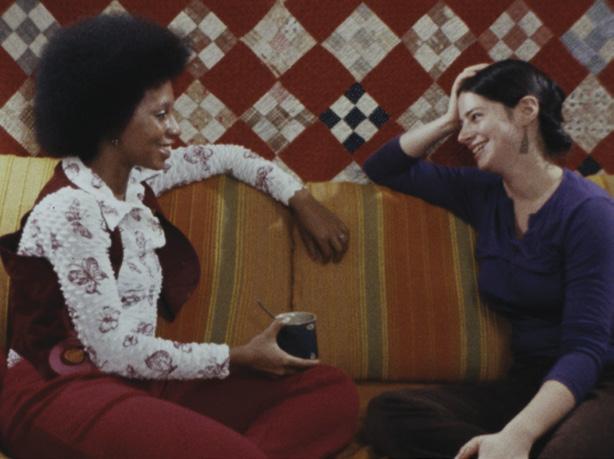
Clockwise from top left: Some of the films showing at the "Restored and Rediscovered" film festival at Jacob Burns Film Center include Household Saints (1993), Peeping Tom (1960), It Happens to Us (1972), and Lady Windemere's Fan (1925).
independent films—even a Cuban satire. Death of a Bureaucrat (1966), directed by Tomas Gutiérrez Alea, is a Kafkaesque comedy about a young man threading his way through the corridors of government. Who knew the Cuban authorities allowed existentialist critiques of their own bureaucracy?
The earliest film in the festival is from 1915, the latest from 2000. (Yes, even relatively recent works may require preservation.)
Lady Windermere’s Fan (1925) is Ernst Lubitsch’s silent film adaptation of Oscar Wilde’s play. It seems like an insuperable task to adapt Wilde’s witty bantering comedy to a medium with essentially no dialogue, but Lubitsch shrewdly translates arch satire into purely visual terms. Luckily, actors of that era had incredibly mobile eyes. And some of the dialogue can be inferred from lip reading.
All the silent films will be shown as they were intended to be—with a live pianist improvising. Coincidentally, the musician, Ben Model, is himself a restorer of films, and will give a demonstration-lecture about his preservation efforts on May 18.
The festival includes renowned masterworks like The Third Man (1949), Carol Reed’s noir drama featuring Orson Welles’s most Machiavellian performance. Peeping Tom (1960), directed by Michael Powell, is the terrifying story of an evil amateur filmmaker: arguably the
English equivalent of Alfred Hitchcock’s Psycho, which was released the same year. Both movies suggest that voyeurism—the essential act of watching a movie—is itself a form of violence.
More esoteric offerings include Harlem on the Prairie, a Western made for African-American audiences in 1937 and filmed at a black-owned ranch in Apple Valley, California. The film includes music by the Four Tones. Rare Blue Apes of Cannibal Isle (1974) is a treat for connoisseurs of the obscure. Shot in Malaysia by sexploitation auteur Donn Greer, Rare Blue Apes is a children’s film, with singing actors in huge animal masks—something like “Sesame Street” if it were set in a Hindu temple.
For tragic reasons, It Happens to Us (1972) is newly relevant. Made when abortion was still illegal, this documentary explores women’s experiences ending their pregnancies. Produced and directed by women, it tells harrowing stories—which are today being reenacted throughout the US since Roe vs. Wade was overturned.
The opening night film is Household Saints (1993), Nancy Savoca’s intimate tale of an Italian-American family based on Francine Prose’s fifth novel. A Q&A with Savoca and her producer (and husband) Richard Guay, will follow the screening.
—Sparrow
Miguel Covarrubias, Isami Doi, Aaron Douglas, and Winold Reiss
Curated by Tom Wolf
February 4 - July 21, 2024
This exhibition is made possible through support from the Terra Foundation for American Art.




By comparing the styles and biographies of four artists who crossed paths in New York during the 1920s, Global Connections traces the complicated channels of influence and inspiration within the often-overlooked multiculturalism of American art before the Second World War.
MUSEUM
PALTZ www.newpaltz.edu/museum

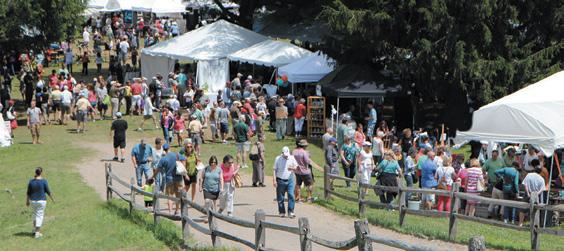




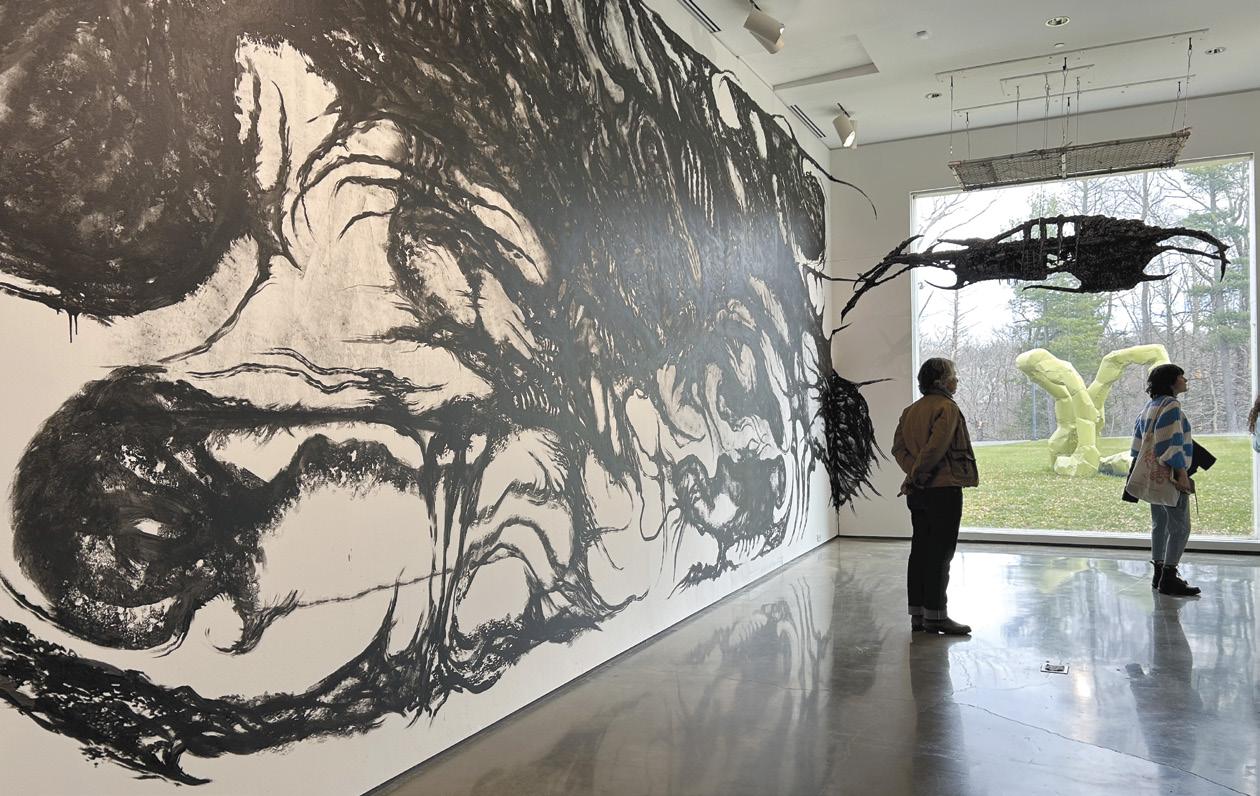
Filled to the Brim “SPILLOVER” AT THE HESSEL MUSEUM OF ART
Through May 26
Ccs.bard.edu/museum
With the fiery blaze of the polarizing press surrounding the Whitney Biennale aflame, it seems appropriate that the ever-progressive Bard College would align with the seasonal engorgement that the art-world is so famous for—and Bard delivers. The current exhibition “Spillover” is a brilliant example of everything that we both admire and question about the integrity of the art-school-prep for a career in the art industry—its creative core, its visibility, its viability, and its potential commercialization. Featuring a collection of 11 curatorial projects (i.e., thesis exhibitions) organized by 11 soon-to-be graduates of the Center for Curatorial Studies Masters of Art program, “Spillover” reflects the raw intelligence and talent of this class. According to the brochure, “Spillover” aims to “create a sequence of distinct but converging artistic encounters” that “connect through their leaking points.” With these vaporous notions as the baseline, one must consider the ways in which the highflown-ness of art pushes its audience into a realm of cerebral oblivion by way of conceptual smothering. Yet isn’t that the aspiration of a biennale-style show such as this one?
Nevertheless, the lively opening in early April provided a slice of vintage art-school anthropology;
tender soon-to-be graduates savoring the moment (pressure posing as elation) clad in trashy-meetscouture duds (style overload) mulling about as famous-looking faculty chatted casually about far-flung professional projects (did someone say Doha again?) all while frolicking families did their best to navigate the aesthetical-metaphysical challenge of this complex show (truly a satire of sorts).
One sentence from a wall didactic for the section A Subtle Remainer curated by Clara Prat-Gay shines as a supreme example of the fun to be found amid the spectacle: “In this exhibition there might not be a lot to see” with respect to the artistic nothingness of air, pressure, and speed as embodied by some of the works (insert metaphorical “silly cracking-up face” emoji here).
Although the separate rooms identify distinct themes as described by the curators—concepts such as hegemonic discourses, cultural forms, collective hauntings, unreadable threats, self-possessed speech, dispersed geographies, modes of translation, notions of home and dislocation, private mythology, temporality, and the affordability of art—to cite all 11 curatorial blurbs—the overall vibe is intense and incorruptible. And while all 11 of these exhibitions strive at something special, the standout exhibitions are “Glot,” organized by Sophie Rose, “Your Presence is a Present,” organized by Dare Dada, and “Weight of Mind” by Thalia Stefaniuk. Spillover presents some great artworks (and some strong attempts at great art). Among the most impactful pieces include an installation Untitled (2024) by the artist vvxxii (b. 1982) that consists of a gnarly black wall drawing-cum-graffiti composition and accompanying sculpture that look like an explosion of calligraphy chaos
infused with monstrosity by way of ruination. (Yes, all that). An animated video The Diadal (2022) with a psycho-thrilled edge by Hannah Rose Stewart suggests that artists have maxed out familiar tropes (gooey pink slime and filmic visuals inspired by The Shining have run their course) while a series of compositionally compelling digital prints titled Resident Aliens (2021-present) by Guanyu Xu highlight the complications that some individuals face while navigating multiple cultural worlds.
To be fair as a critic, there are also a few so-called “leaking points” to state as part of this candid recap: Gaps in the signage and wall text in some of the rooms invited confusion (several of us could not figure out the sequence of curated spaces) and nearly everyone I spoke to about the exhibition layout was uninformed (including docents and guard staff).
As I made my way to the exit after not being able to squeeze into a packed room to witness a live performance, the last artwork that I encountered encapsulated the obvious-versus-implied thrust of the “Spillover” curatorial agenda: The work Sintesis (1972) by Victor Grippo, consisting of a small potato and an equally small piece of coal side-by-side in a precious vitrine with a caption indicating the artist’s practice, “is characterized by an alchemical imagination.” Precisely the gist of this ambitiously articulate show! And while we secretly admit the art tends to kick around a repetition of theorems, we can delight in the recontextualization and fun-arty-fuckery of it all. The curatorial bravery at Bard is top-notch, and so is “Spillover.” Like its biennalekin just down the river, it is the show to see in in the region this season.
—Taliesin Thomas

Pokey LaFarge
May 3 at Levon Helm Studios in Woodstock
Released this month, Rhumba Country, the 11th album by retro-roots artist Pokey LaFarge, finds the singersongwriter downplaying the noirish slant of much of his earlier output. “There was a time when I glorified sadness because I lost sight of who I was,” says the stylish, questing 40-year-old, who not long ago moved to Maine to work 12-hour days on a farm while reflecting on his life’s path. “But now I understand that creating and expressing joy is my gift, and gifts are meant to be shared…I used to see my music in dark blue, but now I see it in Technicolor.” (Margaret Glaspy goes unplugged May 4; Willi Carlisle waxes May 19.) 7:30pm. $35, $50.
Lyle Lovett and Lisa Loeb
May 11 at UPAC in Kingston
The legendary Lyle Lovett’s career spans nearly 45 years and includes 14 acclaimed albums that draw on country, swing, jazz, gospel, blues, and folk. An awardwinning actor as well as singer and musician, Lovett has appeared such films as Short Cuts, Fear and Loathing in Las Vegas, and Coolie’s Fortune and on TV shows like “True Blood” and “Deadwood.” Bespectacled singersongwriter Lisa Loeb is best remembered for her tender number one hit “Stay (I Missed You)” from the soundtrack to 1994’s Reality Bites. (Norah Jones plays the Bardavon gala May 7; CCE’s “Puttin’ on the Ritz” jumps off May 18.) 8pm. $59-$89.
Simon’s Dream: Music of the Penguin
Cafe Orchestra
May 12 at The Local in Saugerties
Since the 1997 passing of founding Penguin Cafe Orchestra leader Simon Jeffes, members of the English avant-chamber group have continued to keep its music alive. Simon’s Dream, which features original PCO multiinstrumentalist Jennifer Maidman and trombonist Annie Whitehead along with drummer Jerry Marrotta (Peter Gabriel), Scott Pettito (Fugs), Jonathan Talbot (Lucky Five), and Liam Singer (Avalon Lounge), does exactly that, starting with selections from the ensemble’s selftitled 1976 debut on Brian Eno’s Original Music label. (Ana Egge emotes May 18; Sonny Singh sings Sikh and Punjabi rock May 25.) 7pm. $24.31.
Colin Stetson
May 12 at Opus 40 in Saugerties
Saxophonist and multi-reedist Colin Stetson may be familiar to some for his collaborative work with Lou Reed, LCD Soundsystem, the National, Arcade Fire, Tom Waits, TV on the Radio, Feist, Bon Iver, the Chemical Brothers, and Bill Laswell. And on the experimental jazz front, the hard-blowing Canadian horn man, who doubles on clarinet, bass clarinet, cornet, flute, and French horn, is a force in his own right; a master of circular breathing who leads his own projects and has performed on numerous film soundtracks. (the Meridian Brothers pass by May 9; Nick Hakim grooves May 29.) 5:30pm. $25.
Marc Ribot’s Ceramic Dog
May 12 at Tubby’s in Kingston
One of today’s most innovative guitarists, Marc Ribot came on the scene via the Lounge Lizards and Tom Waits’s 1980s albums Rain Dogs and Frank’s Wild Years. He’s also done pivotal playing with Elvis Costello, John Zorn, Laurie Anderson, Robert Plant and Allison Krauss, Cibo Matto, Elton John, Neko Case, and others, operating within such varied realms as avantexperimental, jazz, punk, no wave, classical, and Cuban music. Ceramic Dog is his high-powered trio with drummer Ches Smith and bassist Shahzad Ismaily. (Joe McPhee jams with Michael Foster’s the Ghost May 5; Damon and Naomi return May 10.) 7pm. $30.13.
O+ Benefit with Allison Russell
May 24 at Old Dutch Church in Kingston
Canadian singer-songwriter and activist Allison Russell was already soaring in the folk scene as a member of Birds of Chicago when she joined Rhiannon Giddens, Amythyst Kia, and Leyla McCalla in the all-star Americana outfit Our Native Daughters in 2019. Last year, she released The Returner, her second solo album, to notable acclaim. Here, Russell headlines at “O+ 365,” an intimate benefit concert to support the O+ organization’s efforts to address the extraordinary need for ongoing health care access for artists. Opening act to be announced. 7pm. $75-$150.
—Peter Aaron





Exploring Proximate Mysticisms
Justin Vivian Bond (Athens, NY)
Jesse Bransford (Catskill, NY)
Lionel Cruet (Harlem, NY)
Paula Hayes (Athens, NY)
Elizabeth Insogna (Brooklyn, NY)
Fred Kahl (Brooklyn, NY)


415 GALLERY
415 MAIN STREET, ROSENDALE
“Roy Gumpel: Photographs From Over 50 Years.” Five decades of photos from a frequent Chronogram contributor. May 3-17.
510 WARREN ST GALLERY
510 WARREN STREET, HUDSON John Lipkowitz: “Bears, Cats, Ice, and Two Elephants.” May 3-26.
THE ALDRICH CONTEMPORARY ART MUSEUM
258 MAIN STREET, RIDGEFIELD, CT
“Eminem Buddhism, Volume 3.” Work by Elizabeth Englander. Through October 20.
“Layo Bright: Dawn and Dusk.” Work by Layo Bright. Through October 20.
ART OMI
1405 COUNTY ROUTE 22, GHENT
“Olalekan Jeyifous: Even in Arcadia...” Picturesque portrayals of idyllic pastoral life with glimpses of a retro-futurist urban protopia set within the Hudson Valley. Through June 2.
ARTS SOCIETY OF KINGSTON
97 BROADWAY, KINGSTON
“Found Objects, Constructive Reality.” Group members show. May 4-29.
BANNERMAN ISLAND GALLERY
150 MAIN STREET, BEACON
“John Fleming Gould (1906–1996).” Work by the renowned artist and illustrator. Through June 2.
BAU GALLERY
506 MAIN STREET, BEACON
“Brief Lives & Other Ruptures.”. Work by Daniel Berlin. May 11-June 2. “Hybridity.” Sculpture by Joan Harmon. May 11-June 2.
BILL ARNING EXHIBITIONS / HUDSON VALLEY
17 BROAD STREET, KINDERHOOK
“Other Realities.” Work by Justin Vivian Bond, Jesse Brandsford, Lionel Cruet, Paula Hayes, Elizabeth Insogna, and Fred Kahl. Through June 23.
Birds With Prominent Yellow, Leslie Roberts, acrylic gouache, colored pencil, ink, graphite on 3/8-inch MDF panel 10" x 8", 2020. From the exhibition “A Field Guide to Birds” at Garrison Art Center through May 5.
CAROL COREY FINE ART
6 NORTH MAIN STREET, KENT, CT
“A World Between Worlds...” Work by Nathaniel Aric Galka. May 4-June 9.
CATSKILL ART SPACE
48 MAIN STREET, LIVINGSTON MANOR
“Lenore Malen, Debra Pearlman, Samantha Modder, Amy Yoes.” May 4-June 22.
THE CENTER FOR PHOTOGRAPHY AT WOODSTOCK
474 BROADWAY, KINGSTON
“Counter Histories” Photographs by Tamara Abdul Hadi, Alan Chin, Naomieh Jovin, Billy H. C. Kwok, and Qiana Mestrich. Through May 26.
CLARK ART INSTITUTE
225 SOUTH STREET, WILLIAMSTOWN, MA
“Paper Cities.” Group show examining representations of well-known cities in works on paper created between the late fifteenth and the early twentieth century. Through June 23.
CMA GALLERY
AQUINAS HALL, MOUNT SAINT MARY’S COLLEGE, NEWBURGH
“Mandorla in Pieces.” Work by Joan Ffolliott and Charles Purvis. Through May 26.
CORCORAN COUNTRY LIVING
319 WALL STREET, KINGSTON
“Now & Then Art Show.” Art by Anderson Center for Autism students. Through May 28.
CRAVEN CONTEMPORARY
4 FULLING LANE, KENT, CT
“The Animals.” Work by David Shrigley. Through June 2.
DIA BEACON
3 BEEKMAN STREET, BEACON
“Andy Warhol: Shadows.” An installation that surrounds the viewer with a series of canvases presented edge-to-edge around the perimeter of the room. Long-term view.
DISTORTION SOCIETY
155 MAIN STREET, BEACON
“Nico Mazza: Swan Song.” Embroidered textiles. Through June 13.
ELIJAH WHEAT SHOWROOM
195 FRONT STREET, NEWBURGH
“Loves Cats, Hates Catastrophes.” Work by Michael Hambouz. Through May 12.
FORELAND
111 WATER STREET, CATSKILL
“Jackie Fischer.” Large-scale fiber works. Through June 30.
FRONT ROOM GALLERY
205 WARREN STREET, HUDSON
“Passages.” Large-scale abstract landscape paintings by Peggy Cyphers. Through May 19.
GALLERY 40
40 CANNON STREET, POUGHKEEPSIE
“This is Us+.” Work by Paola Bari, Mary Ann Glass, Leslie Bender, and Nansi Lent. May 1-June 30.
GALLERY 495
495 MAIN STREET, CATSKILL
“Light Beings.” Work by Catalina Viejo Lopez de Roda. Through May 25.
GARRISON ART CENTER
23 GARRISON’S LANDING, GARRISON “Shift.” Work by M. Pettee Olsen Through May 5.
“A Field Guide to Birds.” Work by Debra Ramsay and Leslie Roberts. Through May 5.
GREEN
92 PARTITION STREET, SAUGERTIES
“Center Ring.” Wood carvings by Janice Mauro and mixed media photo collage by Wayne Montecalvo. Through May 12.
GREEN KILL
229 GREENKILL AVENUE, KINGSTON
“Richard Kroehling.” Multimedia presentation. May 11-June 29.
HAWK + HIVE
61 MAIN STREET, ANDES
“Breathing Work.” Work by Ariel Bullion Ecklund. Through May 19.

David Becker with the scale model of the Time and Space Limited gallery that he created to layout and plan his show of paintings, “Yesterday’s Tomorrow,” which will be on display May 25-July 7. Photo by David McIntyre
HESSEL MUSEUM OF ART/CCS BARD BARD COLLEGE, ANNANDALE-ONHUDSON
“Spillover.” Collection of 11 curatorial projects by CCS Bard’s 2024 graduating class. Through May 26.
HUDSON HALL
327 WARREN STREET, HUDSON
“Talking Pictures.” Work by Michael LindsayHogg. May 20-June 2.
HUDSON RIVER MUSEUM
511 WARBURTON AVENUE, YONKERS
“Rivers / Flow: Artists Connect.” Group show. Through September 1.
HUDSON VALLEY LGBTQ+ COMMUNITY CENTER
300 WALL STREET, KINGSTON
“Phantasmagoria.” Group show. Through June 15.
JANE ST. ART CENTER
11 JANE STREET, SAUGERTIES
“Off the Charts: Medical Art and the Internal Body.” Group show. Through May 11.
“Out on a Limb.” Work by Suprina Kenney. May 18-June 22.
KENISE BARNES FINE ART
7 FULLING LANE, KENT, CT
“Miracle Island.” Paintings by K. K. Kozik. Through May 12.
KINOSAITO
115 7TH STREET, VERPLANCK
“Wrk Frm Hm.” Work by Alina Tenser. Through May 5.
LABSPACE
2642 NY ROUTE 23, HILLSDALE
“GUZMAN: Family/Values.” Photographs. May 4-June 30.
LEHMAN LOEB ART CENTER
124 RAYMOND AVENUE, POUGHKEEPSIE
“Making a Life in Photography: Rollie McKenna.” Survey of the prolific career of American photographer Rosalie (Rollie) Thorne McKenna (1918–2003). Through June 2.
LIGHTFORMS ART CENTER
743 COLUMBIA STREET, HUDSON
“Life.Death.Life.” Art installation by S. Moss and Vilma Mare. Through May 13.
THE LOCAL
16 JOHN STREET, SAUGERTIES
“From Sky to Sea.” Work by Ruth Soffer curated by Emerge Gallery. May 2-June 16.
LOCKWOOD GALLERY
747 ROUTE 28, WEST HURLEY
“Double Landscapes: Tony Thompson (19382024).” Paintings. Through May 18.
MAD ROSE GALLERY
5916 NORTH ELM AVE, MILLERTON
“Out of Exile”. Photographs by Fred Stein. Through May 5.
“This Must Be the Place?” Photographs by Alon Koppel, Lee Day, and Jada Fabrizio. May 9-June 9.
MAGAZZINO ITALIAN ART
2700 ROUTE 9, COLD SPRING
“Germinal.” Paintings by Mario Schifano (19341998). Through August 9.
“Welcome to New York!” Work by Michelangelo Pistoletto. Through June 24.
MARK GRUBER GALLERY
13 NEW PALTZ PLAZA, NEW PALTZ
“Linda Puiatti, Carolyn H. Edlund, Staats Fasoldt.” Paintings. Through May 18.
MARY MACGILL
212 MAIN STREET, GERMANTOWN
“A Rare Bird, Flower.” Watercolors and graphite drawings by Emma Larsson. May 10-July 15.
MASS MOCA
1040 MASS MOCA WAY, NORTH ADAMS, MA
“Like Magic.” Work by Simone Bailey, Raven Chacon, Grace Clark, Johanna Hedva, Gelare Khoshgozaran, Cate O’Connell-Richards, Rose Salane, Petra Szilagyi, Tourmaline, and Nate Young. Through August 31.
THE MOUNT
2 PLUNKETT STREET, LENOX, MA
“Sculpture at the Mount.” Juried group sculpture show. May 20-October 20.
NORMAN ROCKWELL MUSEUM 9 ROUTE 183, STOCKBRIDGE, MA
“Mystery and Wonder: Highlights from the Illustration Collection.” Illustrations. Through June 16.
OLANA
5720 ROUTE 9G, HUDSON
“Afterglow: Frederic Church and the Landscape of Memory.” Paintings. May 12-October 27.
OLD DUTCH CHURCH
272 WALL STREET, KINGSTON
“Circle 24 Collective Art Exhibit.” Through May 31.
OLIVE FREE LIBRARY
4033 ROUTE 28A, WEST SHOKAN
“Fabrication.” Group exhibition of fiber and textile art. May 18-July 6.
PAMELA SALISBURY GALLERY
362 1/2 WARREN STREET, HUDSON
“A Celebration of the Small.” Work by Lothar Osterburg. Through June 9.

ROBIN RICE GALLERY
234 WARREN STREET, HUDSON “IMHO.” Photographs by David Saxe. Through June 2.
ROLLING AROUND
80 RAILROAD STREET, GREAT BARRINGTON, MA
“David Humphrey and Jennifer Coates.” Through May 5.
SAMUEL DORSKY MUSEUM OF ART
1 HAWK DRIVE, SUNY NEW PALTZ
“Global Connections.” Work by Miguel Covarrubias, Isami Doi, Aaron Douglas, and Winold Reiss. Through July 21.
SAVAGGI GALLERY AT BANK ARTS CENTER
94 BROADWAY, NEWBURGH
“Kate Raudenbush: Inner Landscapes.” Monumental sculptures. Through May 15.
SEPTEMBER
4 HUDSON STREET, KINDERHOOK
“Annie Bielski.” Solo exhibition. May 18-July 7.
SPENCERTOWN ACADEMY ARTS CENTER
790 ROUTE 203, SPENCERTOWN
“Perspective: Six Artists.” Painting, photography, and sculpture by Diahann Addison, Jeffrey All, Amy Cheng, Isabel Cotarelo, Takeyce Walter, and Kenneth Young. Through May 12.
STORM KING ART CENTER
1 MUSEUM ROAD, NEW WINDSOR
“Arlene Shechet: Girl Group.” Six large-scale outdoor sculptures—spanning heights of 10 to 20 feet and lengths of up to 30 feet—along with complementary indoor works in wood, steel, and ceramic. May 4-November 10.
SUPER SECRET PROJECTS
484 MAIN STREET, BEACON
“Dispatches from the Tutti Frutti.” Work by Elin Lundman. May 11-June 6.
SUSAN ELEY FINE ART
433 WARREN STREET, HUDSON
“Talking Threads.” Work by Ana Maria Farina, Courtney Puckett, Eozen Agopian, Hanna
Washburn, Melissa Dadourian, Padma Rajendran, Richard Saja. Curated by Karlyn Benson. Through May 12.
Henry Hudson's Half Moon, from the exhibition “John Fleming Gould (1906-1996),” which features work by the renowned artist and illustrator at Bannerman Island Gallery in Beacon through June 2.
TANNERSVILLE WORKS
6041 MAIN STREET, TANNERSVILLE
“Flowers in Wind.” Paintings by Matthew Izzo. Through May 15.
THE D.R.A.W. STUDIO
20 CEDAR STREET, KINGSTON
“Eureka!” Group show. Through May 6.
THE LACE MILL GALLERIES
165 CORNELL STREET, KINGSTON
“Lanette, Friends and Couples.” Group show. May 4-May 26.
THE RE INSTITUTE
1395 BOSTON CORNERS ROAD, MILLERTON
“Julia Kuning, Barbara Zucker, Meg Lipke, Catherine Hall, Joanne Howard.” Group show. May 4-15.
THOMAS COLE NATIONAL HISTORIC SITE
218 SPRING STREET, CATSKILL
“Native Prospects: Indigeneity and Landscape.” 19th-century paintings by Thomas Cole featuring native figures in context with work by contem-
porary Indigenous artists Teresa Baker, Brandon Lazore, Truman T. Lowe, Alan Michelson, and Kay WalkingStick. May 4-October 27.
TIME AND SPACE LIMITED
434 COLUMBIA STREET, HUDSON
“Yesterday’s Tomorrow.” Work by David Becker. May 25-July 7.
TIVOLI ARTISTS GALLERY
60 BROADWAY, TIVOLI
“Our Only Planet.” Group members’ exhibition. Through May 26.
TREMAINE ART GALLERY AT THE HOTCHKISS SCHOOL
11 INTERLAKEN ROAD, LAKEVILLE, CT
“Dialogue: Art in Conversation.” Work by Nathaniel (Tate) Klacsmann and Valerie Hammond. Through June 2.
TURLEY GALLERY
98 GREEN STREET, SUITE 2, HUDSON “Foregrounds and Horizon Lines.” Work by Joey Parlett. Through May 12.
WEIRD SPECIALTY STUDIO
77 BROADWAY, TIVOLI
“Emily Johnston and Sarah Mitchell-Davison.” Through June 9.
WEST STRAND ART GALLERY
29 WEST STRAND STREET, KINGSTON
“Portraits Shaping Memories.” Work by Amy Fenton-Shine, Vanessa Osmon, and Julia Santos Solomon. Through May 12.
WILLIAMS COLLEGE MUSEUM OF ART
15 LAWRENCE HALL DRIVE, WILLIAMSTOWN “Emancipation: The Unfinished Project of Liberation.” Work by Sadie Barnette, Alfred Conteh, Maya Freelon, Hugh Hayden, Letitia Huckaby, Jeffrey Meris, and Sable Elyse Smith. Through July 14.
WINDOW ON HUDSON
43 SOUTH 3RD STREET, HUDSON
“Pressing Matters.” Monoprint by Nancy O’Hara Through May 12.
WIRED GALLERY
11 MOHONK ROAD, HIGH FALLS
“Origins: The Artwork of Edward M. O’Hara.” Paintings and drawings. May 11-June 9.
WOODSTOCK ARTISTS ASSOCIATION AND MUSEUM
28 TINKER STREET, WOODSTOCK
“Kelsey Renko: you and me.” Paintings. Through June 2.
“Melting Pot.” Group show juried by Elisa Pritzker.
WOODSTOCK SCHOOL OF ART
2470 ROUTE 212, WOODSTOCK
“Segalman at 90.” Oil paintings, watercolors, monotypes, charcoal drawings, and pastel paintings of Richard Segalman from the private collections of his Woodstock circle of friends. Through May 4.

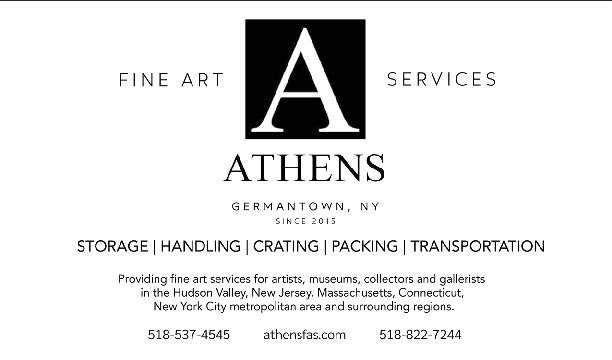






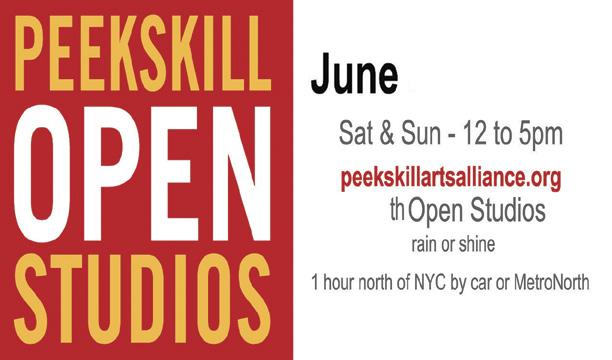









May begins with a cluster of planets in sumptuous, stable Taurus, including Venus in her home sign. For those of you who participate in Beltane festivals, you could not ask for more idyllic conditions. By May 15, Mercury joins the party, which brings us to five planets occupying the sign most symbolic of our bodies, the natural world, and material pleasures. It’s at this point in the season that we’re most in touch with our appetites for comfort, indulgence, and beauty.
The new Moon in Taurus on May 7 would be an auspicious time to quietly assess changing tastes, deficits of rest, and financial security. Taurus also represents economics and our sense of scarcity and abundance. Please stop and smell as many roses as you can, because the cosmological rhythm takes a dramatic turn as we head into the second part of the month.
On the 20th, the Sun enters Gemini, and the pace picks up considerably. We go from smelling roses and napping in the grass to not wanting to miss out on any activity, conversation, or chance at learning something new.

Curiosity and restlessness reach fever pitch on May 23 as a full Moon in Sagittarius has us questing for knowledge, meaning, and experience. Venus enters Gemini on this day as well, turning us toward intellectual delights. On the 25th, the volume gets turned up even more on all the Gemini chatter as Jupiter enters the sign. Jupiter will be in Gemini for approximately one year. During this time we all might feel like gremlins who got fed after midnight. We’ll get to experiment with our own dualities, needs for movement, and exponential multiplications. We’ll yearn for the multilingual, and turn every “eitheror,” into “both and more.” It could get confusing, but it won’t be boring.

(March 20–April 19)
All of the small communications that we take for granted contain greater meaning this year, including communications that you have with yourself. There is no such thing as an idle question or a lazy daydream as they are now imbued with teachings that expand your mind. That being said, this year is a great time to embark upon a course of study, turn your newsletter into a book, or transform superficial relationships into meaningful connections. The increase in daily activity and interactions coming up can rise above mere busyness and offer true mental coherence. Siblings can turn into good friends, or business partners.

(April 19–May 20)
Just as you were settling into your relaxing element, you’re prodded to get up and get out into the fray towards month’s end. There are people to meet and multiple places you have to be—maybe all at once! People want what you’ve got, and it’s time to play Let’s Make a Deal. Reevaluate what you have and what it’s worth. This includes what’s in your bank account and what’s in your toolbox of skills. What is it all worth to you? When you can answer that question, and feel good about it, you’ll be ready to negotiate some exchange rates.
Cory Nakasue is an astrology counselor, writer, and teacher. Her talk show, “The Cosmic Dispatch,” is broadcast on Radio Kingston (1490AM/107.9FM) Sundays from 4-5pm and available on streaming platforms. AstrologybyCory.com

GEMINI (May 20–June 21)
As if you needed more license to follow your curiosities, change your mind(s), and perform radical feats of agility—it arrives in the form of Jupiter in your sign. This offers more than just haphazard variety (although that is a definite possibility if not harnessed), it also offers coherence. Over the next year with Jupiter in your sign, you have the opportunity to synthesize your many contradictory facets into one brilliant gem of personal expression. You’re about to learn more about the glue that holds all the pieces together instead of focusing on the pieces themselves. As Walt Whitman says, “I contain multitudes.” You do, too.

(June 21–July 22)
Cancer is very familiar with the womb, the tomb, the home, and the tight hug. It gets a little nervous in wideopen spaces where it can’t feel containment. You’re entering a period where the edges of your consciousness are getting broader, and you’re more willing to explore spaces that have less definition. Dream states and other altered states seem less scary now and may even hold some fascination. They definitely hold information you might need to heal or reconcile old wounds. This coincides with your usual emotional purge right before your birthday. This is an ideal time for divination practice.

LEO (July 22–August 23)
Career gains or shifts in reputation over the past year have resulted in a new audience, group of colleagues, or support network. These people represent a treasure trove of possible help for your projects. I’m also happy to report that engaging with these people looks highly enjoyable. You’re widening your social circle and sphere of influence. To make the most out of these new contacts, open yourself to people who you think you have nothing in common with. Don’t be too loyal to certain types of personalities or circumstances you’re comfortable with. A new social persona is emerging.

VIRGO (August 23–September 23)
Repeat after me, Virgo: “I do not need to be perfect to deserve visibility.” The same goes for your projects. You are a never-ending work in progress, as we all are, and that is beautiful. Besides, if you’re hiding, how are any new collaborators going to find you? The scope of what you’re trying to accomplish in life is expanding and you’re going to need help bringing a multitude of ideas to fruition. You’re about to get more appreciation for your adaptability and communication skills. These would be the things to showcase right now. Perfection is static. You need movement.

LIBRA (September 23–October 23)
You have many opportunities to broaden your horizons over the next 12 months by engaging with people who are different from you. Talk to people from different backgrounds and different political views, and entertain social practices you might not agree with. Go outside of your intellectual comfort zone to unlock mind-expanding benefits that will also expand life potentials. If you’re looking for teachers, guides, or courses of study, you are primed for digesting large quantities of information. If you’re planning to travel, go somewhere you’ve never been. It is not a time to stick with the familiar!









SCORPIO (October 23–November 22)
Your propensity for diving down mysterious rabbit holes is rewarded over the next 12 months. The most compelling information will be located in the minds, hearts, and bank accounts of other people. You seem to be developing a sixth sense about who has precisely the resources, talents, and expertise you need to make profound changes to material circumstances. This will require you to trust your collaborators, lest you scare them off with stringent tests of virtue. Idle curiosities turn into obsessions, and the more taboo a subject is, the greater its lure. Others are just as curious about the mysteries you hold.

(November 22–December 22)
This month, Jupiter, the ruler of your nativity, moves into your opposite sign of Gemini (along with the Sun and Venus). This will be at once irritating and exhilarating for your closest partnerships. Expect an uptick in conversations and interactions but also a demand for you to pay more attention to details and hard facts. Typically, Sagittarius runs on faith, belief, imagination, and enthusiasm, but this month’s pileup in Gemini asks for more objectivity and capacity to hold multiple truths at the same time. Yes, Sagittarius, multiple truths CAN exist at the same time even if they seem to conflict.

CAPRICORN (December 22–January 20)
Of all the signs in the zodiac, yours is the least afraid of some hard work. Capricorn may even be the most likely to say, “Bring it on!” There is a lot of support on offer for you to tackle a big project. You may even be able to complete something by this time next year with amazing results. You are being asked, however, to diversify, multitask, and possibly delegate your responsibilities to others. This is where things get uncomfortable but present a growth edge for you. Work only with trustworthy people and dare to loosen up.

AQUARIUS (January 20–February 19)
Is it possible to have too much fun? Is it possible to be too inspired, expressive, and mentally stimulated? You’re about to find out. We all react differently when presented with too many opportunities that we find attractive. Some of us get paralyzed with overwhelming fear of picking the wrong thing. Some of us become giddy and overestimate our ability to juggle everything at once. This month, you’re learning to connect the dots between all of the possibilities for enjoyment that are on offer. You’re learning how to take fun less seriously and lose the guilt about changing your mind.

(February 20–March 19)
Things at home are sure to get noisy! Whether it’s an influx of houseguests this spring or a new addition to the family, the places where you seek repose are becoming quite busy. This could include your own heart and mind. Perhaps you’re talking to yourself more, or you’re playing referee or translator between multiple personal needs. This could be a very confusing time, and it could be liberating. All the different parts of you or your household combine to create one family. We are all made up of many different parts. They all need to be in dialogue.
Berkshire
Berkshire
Berkshire
Berkshire
Bistro



This Is Spinal Tap screens May 24 at Opus 40 in Saugerties.

May 3-5 at the Dutchess County Fairgrounds
The Mustang, an iconic symbol of American culture, is set to take center stage at the Rhinebeck Antique Car Show. Celebrate the 60th anniversary of this iconic car at the 52nd iteration of this car swap meet and car show at the Dutchess County Fairgrounds. Not only will this event be a place to drool over a sea of over 300 cars and rare Mustangs, but it will also be a fundraiser for the Carroll Shelby Foundation and the Tunnels to Towers Foundation. $15-$35.
May 4 at UPAC in Kingston
In her latest New York Times bestseller, Prequel: An American Fight Against Fascism, Rachel Maddow tracks the rise of a wild American strain of authoritarianism that has been alive on the far-right edge of our politics for the better part of a century. Before and even after our troops had begun fighting abroad in World War II, a clandestine network flooded the country with disinformation aimed at sapping the strength of the US war effort and persuading Americans that our natural alliance was with the Axis, not against it. Maddow will discuss her book and its contemporary resonance with University of Pennsylvania Professor Anthea Butler. 7:30pm. $49.
May 9 and 10 at Park Theater in Hudson Park Theater continues to bring cutting-edge theater to Hudson—Scott Barrow’s performance in the one-person show “Every Brilliant Thing” in March was fantastic. The intimate theatrical space will host an evening of new short theatrical works by Adam Tomei, Derek Murphy, Geoffrey Nauffts, Joseph Walsh, and Shae D’lyn, staged with minimal sets, costumes, effects, and fewer actors. The bare-bones set-up allows for intimacy and camaraderie. The pieces will be interlaced with live music by folk artist Phil Roebuck. 7pm. $20.
Though May 10 at Mohonk Mountain House Spring has officially sprung! What better way to celebrate the start of the season than by going to view an explosion of spring color at Mohonk Mountain House’s annual Tulip Festival? While taking in the splendor of 20,000 tulips in bloom, indulge in your garden party dreams with floral tea, an assortment of cookies, music, crafts, and cocktails. In addition to these treats, a Tulip pass also includes one-day access to Mohonk’s scenic hiking trails, parking, art exhibits, performances, and more. Secure your tickets in advance, as daily availability is limited. $64.
May 10-12 at Bethel Woods
The Catskill Mountains not only offer breathtaking natural beauty, but are also home to a delicious variety of cuisine. The 2nd Annual Catskill Cuisine will showcase the delicacies of the area with Food Network celebrity chefs like Michael Symon, Scott Conant, and Marcus Samuelsson conducting cooking demos and meet-and-greets throughout the day on Saturday. The weekend wraps up with a Sunday brunch with Anne Burrell and Melba Wilson. $64-$179.
Pride in the Sky
May 17 at Walkway Over the Hudson
Big Gay Hudson Valley, in partnership with Friends of the Walkway, will host the first-ever pride celebration on the Walkway. The evening will feature a DJ-driven dance party at the Walkway’s Center Overlook, along with featured hosts from the LGBTQ+ community and illuminated performers and entertainers. As sunset approaches, a group of 100 flag marshals will carry a 15-foot-wide, 500-foot-long portion of a rainbow flag created for the flag’s 20th anniversary in 1998. Featuring the original 8 color stripes, this section of the flag will be carried by flag marshals from the Dutchess County side to the Ulster County side of the Walkway. Free. 6-10pm.
“The Dying Swan and Its Cause of Death” and “Encounter”
May 17 at PS21 in Chatham
PS21 opens its season with a double bill of genredefying works from Japan’s contemporary dance scene. Hana Sakai dances the classic Mikhail Fokine solo ballet “The Dying Swan,” but she begins to wobble while speaking about why she had to die—a hilarious riff by visionary director Toshiki Okada that delves into environmental issues. “Encounter” is choreographed by Moto Takahashi and performed by her all-woman dance group MWMW, who challenge gender norms with their stunning hip-hop techniques and ensemble movements. $35. 8pm.
Faire Hudson Valley
May 18-19 at Garner Arts Center in Garnerville
Part science fair, part county fair, and part tech expo, maker faires are all-ages gathering of tech enthusiasts, crafters, educators, tinkerers, hobbyists, engineers, science clubs, authors, artists, students, and commercial exhibitors. Maker Faire Hudson Valley celebrates this universal drive to create—from crafting to engineering—at the Garner Arts Center. Become immersed in the spirit of innovation with installations, creative demos, immersive VR and robotics experiences. $10.
May 18-19 at Basilica Hudson
The durational music event, subtitled “Experiments in Sound and Music,” allows attendees to bring their sleeping bags and camp inside the reclaimed riverfront industrial building during the performances and includes audio and visual art elements and on-site food vendors. This year’s lineup includes experimental musicians Cowboy Sadness, Nadah El-Shazly, Moundabout, Ghost Ensemble, Tyondai Braxton, and many others. There will also be a special set by Dragonchild, the solo project of Ethiopian saxophonist D. A. Mekonnen of Debo Band fame. $113.30. 12pm-12pm.
May 24 at Opus 40 in Saugerties
The long-awaited sequel to legendary mockumentary This Is Spinal Tap is now in production, almost 40 years after the original film was released. The production has already confirmed cameos by Paul McCartney, Elton John, and Garth Brooks. It’s a good time to revisit the original, in which legendary English heavy metal band Spinal Tap attempt an American comeback tour accompanied by a fan who is also a filmmaker (Rob Reiner). The resulting documentary, interspersed with powerful performances of Tap’s classic songs and profound lyrics, candidly follows a rock group heading toward crisis. Presented by Upstate Films. $10$12. Gates at 7pm, film at 8:30pm.
May 31-June 2 at Hutton Brickyard in Kingston
Founded by renowned interior designer Brad Ford in 2014 as a modern interpretation of a traditional arts and crafts market, Field + Supply brings together a carefully curated selection of nearly 300 makers from across the country for one of the region’s most anticipated maker markets. Each day, guests will also enjoy live music, interactive workshops and programming, food and craft beer and cocktails from local vendors, including Hole in the Wall Donuts, Raven & Boar, Santa Fe, Oyster Party, and Nancy’s Artisanal ice cream. $20-$45. 10am-6pm.
June 1 at Skate Time in Accord
The Hudson Valley’s favorite roller disco party of the season is back. What co-organizer Sean Nutley happily dubs “Studio 54 on Wheels,” the sixth annual Catskills Roller Disco will feature a night of groovy rhythms, funky costumes, dance-offs, and a stacked line-up of DJs, including Wolf + Lamb, Anna Collecta, Laura Lynn, and Sensay Shnay at Skate Time in Accord. $40. Dress to impress. 7-11pm.










